This post contains affiliate links.
This article identifies all hummingbirds documented as seen in Nebraska and where they are seen in the state. It further identifies if that specific hummingbird species is a year-round resident, a seasonal visitor, or a rare vagrant Nebraska hummingbird.
Which Species Of Nebraska Hummingbirds Are Found In The State?
There are eight species of hummingbirds documented as seen in Nebraska.
Documented Nebraska hummingbirds, listed in order of frequency seen are Ruby-throated, Rufous, Broad-tailed, Calliope, Anna’s, Black-chinned, Costa’s and Broad-billed hummingbirds.
Top Google-ranked websites recognize one additional hummingbird, the Allen’s hummingbird, as a Nebraska hummingbird, despite the fact there are just eight species recorded as being seen in Nebraska on a national hummingbird sighting map.
Listed In The Order Of Frequency Seen:
These are the Nebraska statistics at the end of 2023, as reported by eBird.org.
Click the “Documented” link below for the current Nebraska stats.
| Hummingbirds: | Numbers Seen: | Documented: |
| Ruby-throated | 6,588 | Documented |
| Rufous | 163 | Documented |
| Broad-tailed | 151 | Documented |
| Calliope | 109 | Documented |
| Anna’s | 39 | Documented |
| Black-chinned | 38 | Documented |
| Costa’s | 8 | Documented |
| Broad-billed | 2 | Documented |
| Allen’s | 0 | Not Documented |
| Total Seen: | 7,098 |
These 9 hummingbird species are found in Nebraska and are further classified into three groups:
Year-round residents, Seasonal visitors, and Rare/Vagrant visitors.
| Hummingbird: | Year-Round, Seasonal, Rare/Vagrant |
| Ruby-throated | Seasonal |
| Rufous | Rare/Vagrant |
| Broad-tailed | Rare/Vagrant |
| Calliope | Rare/Vagrant |
| Anna’s | Rare/Vagrant |
| Black-chinned | Rare/Vagrant |
| Costa’s | Rare/Vagrant |
| Broad-billed | Rare/Vagrant |
| Allen’s | Rare/Vagrant |
For more information on Nebraska hummingbirds: Read my article: Nebraska Hummingbird Migration
Nebraska Hummingbirds That Are Year-Round Residents
There are no hummingbirds classified as year-round residents in Nebraska.
This year-round hummingbird classification is defined as resident hummingbirds living in Nebraska 365 days a year.
Contrary to popular belief, hummingbirds can withstand far lower temperatures than most people would expect.
Some banded hummingbirds have been observed at temperatures as low as -9 degrees Fahrenheit with a wind chill of -36 degrees Fahrenheit, according to eBird.org.
See my article: 3 Reasons Why Hummingbirds Are Banded
Nebraska Hummingbirds That Are Seasonal
There is only one Nebraska hummingbird classified as a seasonal hummingbird, which is the Ruby-throated hummingbird.
Hummingbirds that fit within this seasonal category are hummingbirds that migrate through Nebraska on a spring or fall migration basis.
Hummingbirds move south to spend the winter in Mexico and Central America in the fall, after migrating north in the spring to reproduce.
Due to their preference, an ailment, or advanced age, certain seasonal hummingbirds may spend the whole winter in the state.
To see a current sighting map of Nebraska seasonal hummingbirds, click the links below:
RUBY-THROATED HUMMINGBIRD – (Archilochus colubris)
Conservation Status: Least concerned
Kingdom: Animalia
Phylum: Chordata
Class: Aves
Order: Apodiformes
Family: Trochilidae
Genus: Archilochus
Species: A. colubris
Scientist Carl Linnaeus of Sweden is credited with giving the Ruby-throated hummingbird its scientific name. He initially classified the species as “Trochilus colubris.”
Its name was revised more than a century later when German botanist Ludwig Reichenbach classed it as “Archilochus colubris,” which is now its scientific name and means “sky spirit/sun-god bird” or “top thief.”
Male Ruby-throated hummingbirds:
The beautiful iridescent blood-red gorget of male Ruby-throated hummingbirds ends at the neck.
His distinctive features are black wings, a light gray underbelly, and a dull metallic green topside.
The Ruby-throated hummingbird is a tiny species of hummingbird, measuring 2.8 to 3.3 inches in length and weighing less than 4.5 grams, or two U.S. dimes.
They live for three to five years on average.
The metal plate that shields the wearer’s throat during combat to prevent injuries is the inspiration behind the name of the gorget on a male hummingbird.
This name is acceptable and fitting to characterize the physical characteristics of male hummingbirds, since they fight fiercely for their own territory.
Read my article: Hummingbird Gorgets Explained
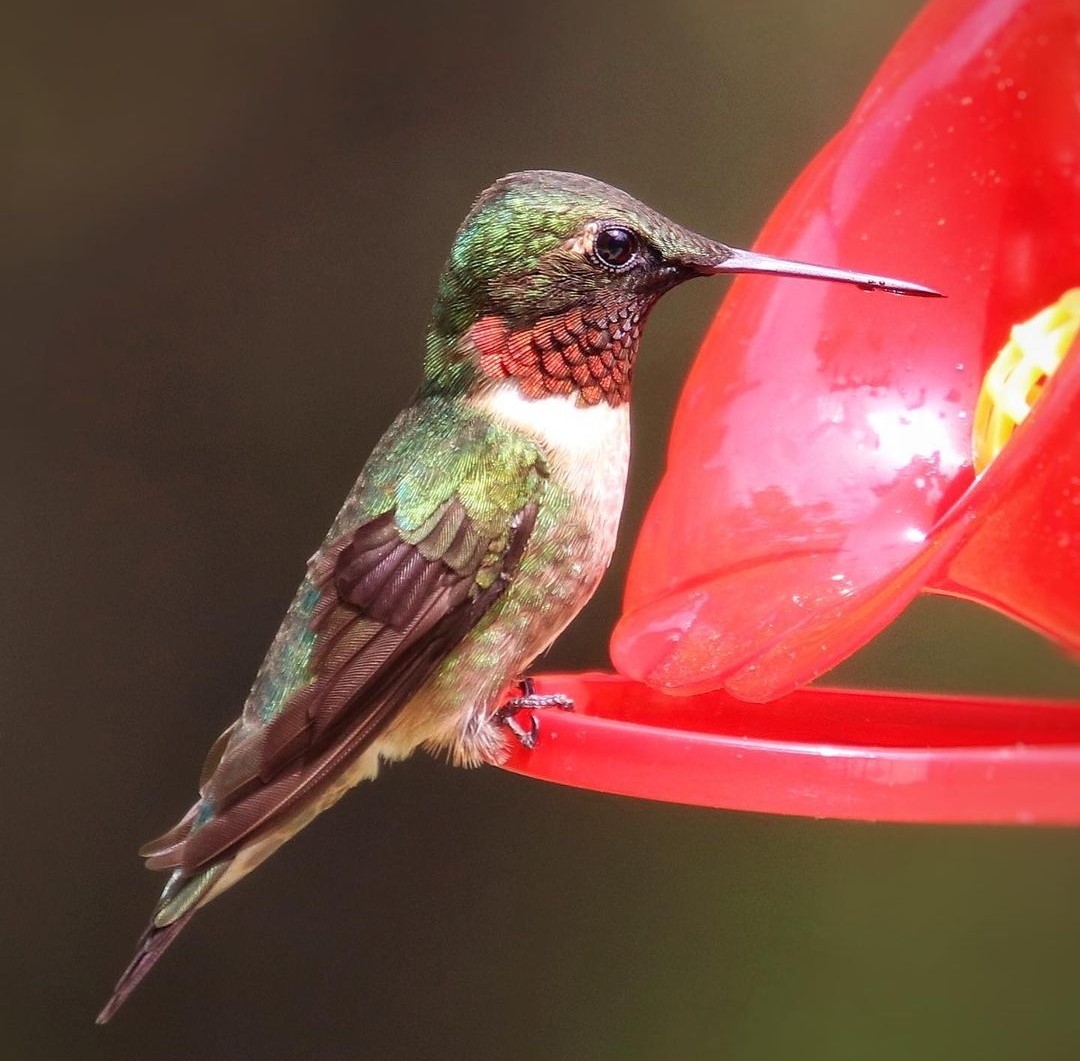
Photo by: Paula Leftwich
Female Ruby-throated hummingbirds:
Ruby-throated hummingbird females are usually larger than males, with a white throat stippled with light spots.
Ruby-throated hummingbird’s life expectancy is roughly three to five years.
The oldest female Ruby-throated hummingbird on record, at nine years old, is nearly twice as old as the male life expectancy.
See my article: Hummingbird Parents: (Mating to Nesting)

Photo by: Dgen.photos
Note: The pollen on her head and beak. This female Ruby-throated hummingbird has been busy pollinating and drinking nectar from flowers to sustain her high metabolism.
Juvenile Ruby-throated hummingbirds:
Ruby-throated hummingbird juveniles, both male and female, have a white throat with faint stippling, just like their mother.
As the males become older, they start to show some color around their necks, and finally their stronger red throat feathers take center stage and proudly show off a vibrant gorget.
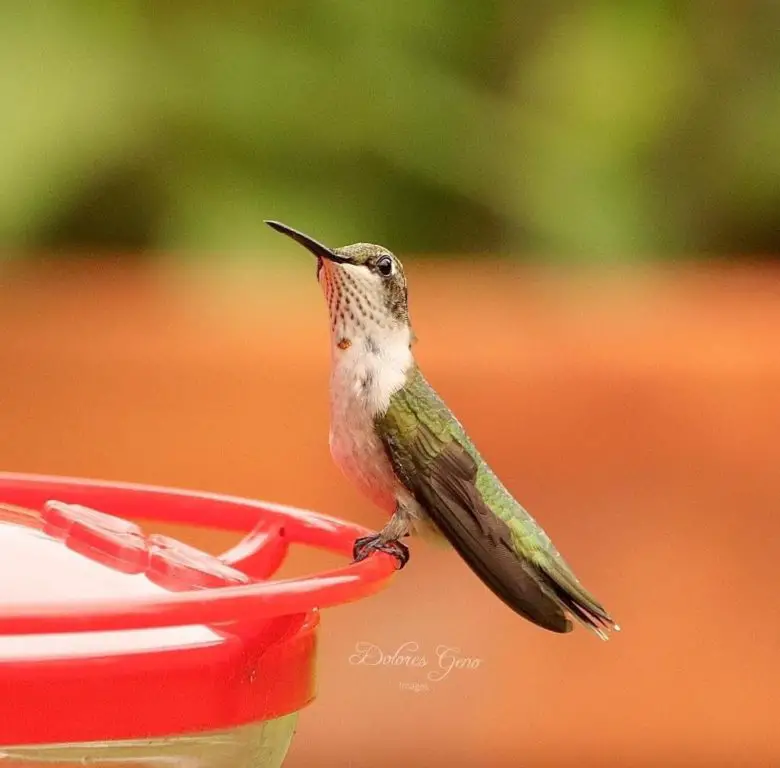
Photo by: Dgen.photos
Note: The throat feathers are slowly coming in, displaying a few dots of color near the neckline and showing the first stages of adolescence.
Baby Ruby-throated hummingbirds:
Baby Ruby-throated hummingbirds are easily identified by their undertail coverts, which are white fluffy feathers near their bottom that will disappear as they age.
See my article: Baby Hummingbirds: (Egg to Fledgling)
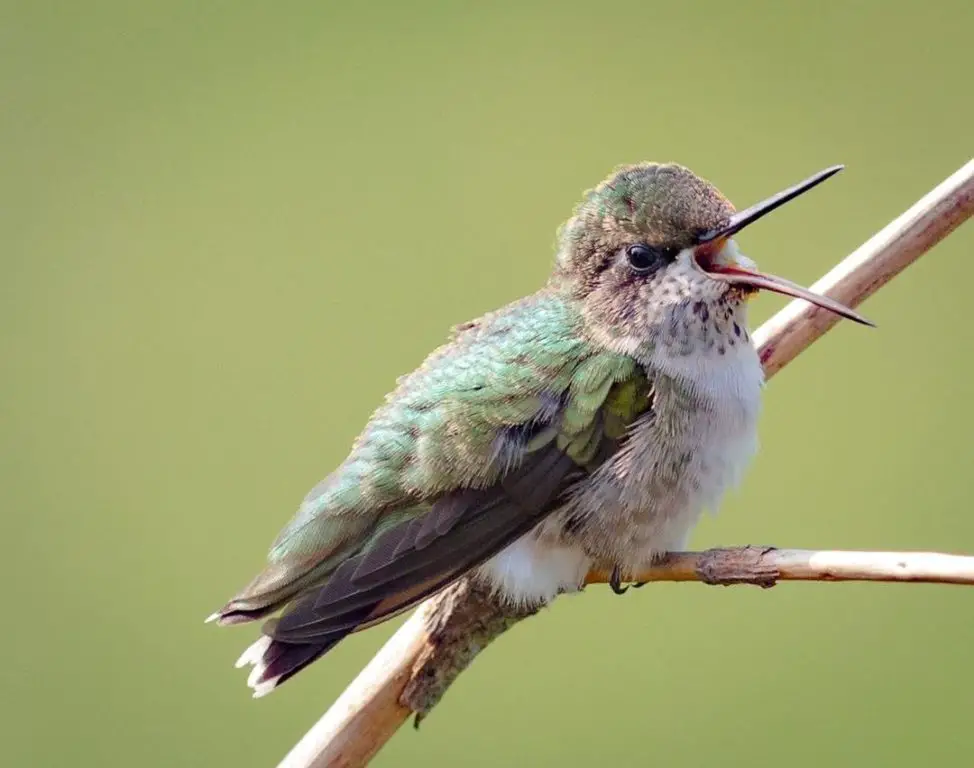
Photo by: Rekha Pawar
Note: The down feathers near the baby’s bottom are newly white and fluffy.
Observe the great fat reserves they have amassed from the feedings of their devoted mother’s, which will help them get through puberty.
To see the current sighting map of Nebraska’s Ruby-throated hummingbirds, click the link.
Hear the sounds of the Ruby-throated hummingbird (Cornell Lab of Ornithology link).
92% of all Nebraska hummingbird sightings will be Ruby-throated hummingbirds.
On average, out of 10,000 hummingbird sightings in Nebraska, 9,281 will be Ruby-throated hummingbirds.
The Ruby-throated hummingbird migrates via two different routes in the spring and fall.
The first migration route takes them directly, via the Gulf of Mexico, southwest to Mexico, where they travel nonstop until they reach Central America for the winter.
Over 500 miles is the flight distance over the Gulf of Mexico. Despite being the direct “short” route, these birds must overcome many difficulties.
The total direct flight from Omaha, Nebraska to Panama City, Panama is 2,439 miles.
Not being able to rest, not having access to food or fuel, and needing to steer clear of the severe tropical Atlantic hurricanes while traveling to their destination are some of the challenges faced when flying over the Gulf of Mexico.
To exacerbate the situation, they migrate during the night or are conducting a “Red-eye flight,” depending on your point of view.
Even though both sexes double their body fat before beginning their arduous transoceanic migratory pattern across the Gulf of Mexico, researchers think that males’ energy consumption is more taxing due to their small stature.
The second land migration path is 3,959 miles long and follows the Gulf of Mexico’s shoreline. Even though there are fewer guarantees of food sources along the way, taking the “long” route gives them the chance to stop and replenish.
Scientists are unclear and continue to investigate why one group of birds would prefer to take one route over the other.
Read my article: Hummingbird Migration in Nebraska
The majority of people are unaware of how tolerant hummingbirds are of chilly weather.
According to eBird.org, through branding practices in Wisconsin, the Ruby-throated and Rufous hummingbirds have been documented surviving in temperatures of -9F and wind chills of -36F.
Read my article: 3 Reasons Why Hummingbirds Are Banded
To provide the many hummingbirds that spend the winter in Nebraska access to life-sustaining nectar, several Nebraska hummingbird enthusiasts keep their hummingbird feeders up all winter long.
This altruistic deed also supplies nectar to other migrating species that are too injured or elderly to travel.
Read my article: 11 DIY Ways to Keep Hummingbird Nectar From Freezing
The Ruby-throated hummingbird is a common sight in parks, gardens, and backyards. It prefers open forests. Except for the breeding season, when they become ferociously territorial and hostile against hummingbirds of other species, they are solitary birds.
Despite their aggressive nature, these hummingbirds are eaten by predators like dragonflies, big crustaceans, praying mantises, and orb-weaver spiders.
Read my article: 10 Common Things That Kill Hummingbirds
Nine years and one month was the oldest known living female Ruby-throated hummingbird, found during a capture and release banding operation in West Virginia.
Read my article: 3 Reasons Why Hummingbirds Are Banded
Nebraska Hummingbirds That Are Rare/Vagrant
There are eight Nebraska hummingbirds classified as rare or vagrant hummingbirds. They are Rufous, Broad-tailed, Calliope, Anna’s, Black-chinned, Costa’s, Broad-billed and Allen’s hummingbirds.
Hummingbirds that live in a group outside of their typical geographic range are classified as belonging to this category of Rare/Vagrant.
These hummingbird species not only span a vast range of distinct geographic areas, but they are also known to occasionally interbreed, giving rise to hybrids.
Although they are not in their usual range, reports of seeing these hummingbirds in Nebraska have been made.
To see a current sighting map of Nebraska rare/vagrant hummingbirds,
click the links below:
RUFOUS HUMMINGBIRD – (Selasphorus rufus)
Conservation Status: Near threatened
Kingdom: Animalia
Phylum: Chordata
Class: Aves
Order: Apodiformes
Family: Trochilidae
Genus: Selasphorus
Species: S. rufous
The Latin word rubrum, which means “red,” is the source of the Rufous hummingbird’s name due to its reddish-brown color.
Male Rufous hummingbirds:
The orange-red gorget of a male rufous hummingbird is iridescent, and their tail and sides have a rusty hue. Their underside is beige to white, and their bill is black.
Along with chocolate brown dorsal feathers, males can also have green plumage with green spots on their rustic-looking backs or on the summit of their heads.
They weigh 3.2 grams and range in length from 2.8 to 3.5 inches.
The metal plate that shields the wearer’s throat during combat to prevent injuries is the inspiration behind the name of the gorget on a male hummingbird.
This name is acceptable and fitting to characterize the physical characteristics of male hummingbirds, since they fight fiercely for their own territory.
Read my article: Hummingbird Gorgets Explained
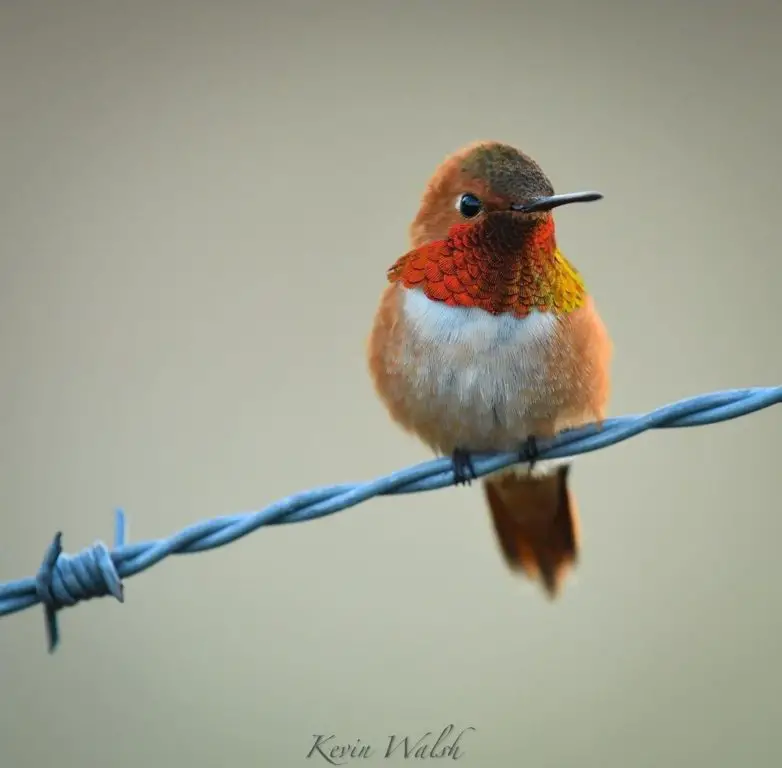
Photo by: Kevin Walsh
Note: The iridescent orange-red gorget.
Female Rufous hummingbirds:
The female Rufous hummingbird is less colorful than the male because it lacks a gorget and iridescent feathers.
In the wild, confusion may arise, though, because certain females have stippling or color specs along their throat line that resemble juvenile characteristics.
They are slightly larger than the males in anticipation of producing offspring.
See my article: Hummingbird Parents: (Mating to Nesting)
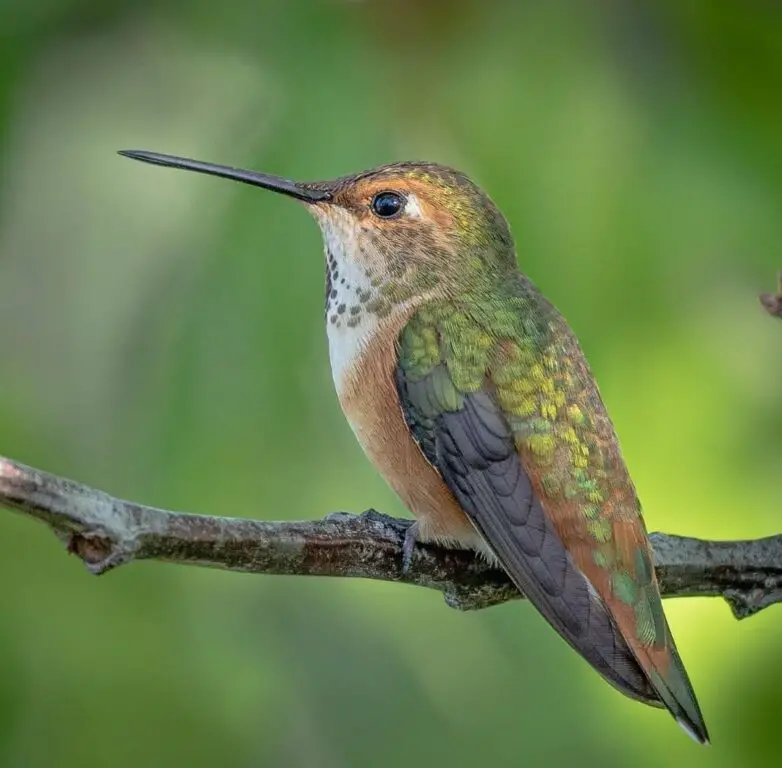
Photo by: Bob Free
They have one of the northernmost breeding ranges of any hummingbird in the world; migrating north from Mexico and nesting as far north as Alaska to breed during the summer months.
They are polygamous and will mate with several partners in a season.
Read my article: Hummingbird Parents: (Mating to Nesting)
Read my article: Baby Hummingbirds: (Egg to Fledgling)
Juvenile Rufous hummingbirds:
In the wild, juvenile Rufous hummingbirds and Allen’s hummingbirds are nearly identical in terms of color and behavior.
Therefore, range rather than appearance is used to establish identity.
The juvenile male Rufous’ rustic appearance is attributed to the iridescent orange dots on their neck.
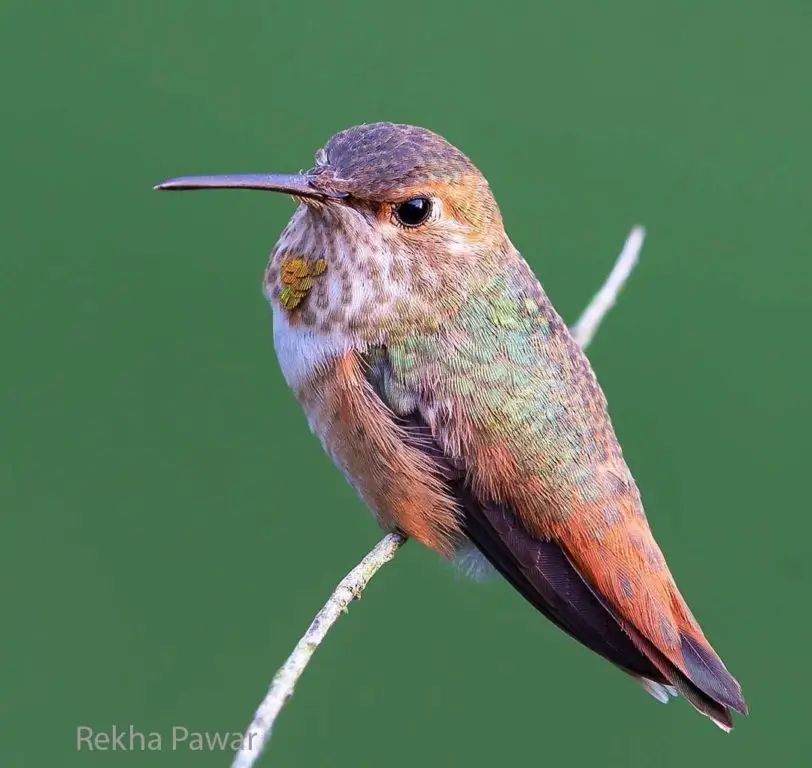
Photo by: Rekha Pawar
Note: The throat feathers are slowly coming in, displaying a few dots of color near his neckline and showing the first stages of adolescence.
Baby Rufous hummingbirds:
Baby Rufous hummingbirds are easily identified by their undertail coverts, which are white fluffy feathers near their bottom that will disappear as they age.
See my article: Baby Hummingbirds: (Egg to Fledgling)
To see the current sighting map of Rufous hummingbirds in Nebraska, click the link.
Hear the sounds of the Rufous hummingbird (Cornell Lab of Ornithology link).
2.3% of all Nebraska hummingbird sightings will be Rufous hummingbirds.
On average, out of 10,000 hummingbird sightings in Nebraska, only 230 will be Rufous hummingbirds.
Of all the birds in the world, Rufous hummingbirds migrate within the United States for the longest period of time. Every year, they traverse 3,900 miles in a clockwise manner around western America.
This migratory pattern during the seasons coordinates their arrival perfectly while catching nectar and blooming flowers throughout the year, fueling their bodies for their long journey.
In order to support a healthy migration, hummingbird enthusiasts are very beneficial when they cultivate blooming plants to draw hummingbirds and supply feeders with homemade hummingbird nectar.
These friendly environments offer and guarantee safe trips in addition to a dependable haven for relaxation and refueling while on the road.
A large number of Rufous hummingbirds will choose to move south to Mexico rather than stay in Nebraska for the winter. Hummingbirds, however, can withstand far lower temperatures than most people think.
According to eBird.org, through branding practices in Wisconsin, the Rufous and Ruby-throated hummingbirds are documented surviving in temperatures of -9F and wind chills of -36F.
See my article: 3 Reasons Why Hummingbirds Are Banded
Many Nebraska hummingbird admirers leave hummingbird feeders up all winter long to provide life-nourishing nectar to the most commonly seen residents: the Rufous and Anna’s hummingbirds.
This selfless act also provides nectar to other injured or older hummingbirds that are unable to migrate.
See my article: 11 DIY Ways to Keep Hummingbird Nectar From Freezing
When it comes to other hummingbirds and animals, Rufous hummingbirds are fiercely possessive and hostile. They are known for being aggressive and bold, driving large birds and rodents away from their favorite feeders in addition to other hummingbirds.
See my article: Why Hummingbirds Chase Each Other: Is it Friend or Foe?
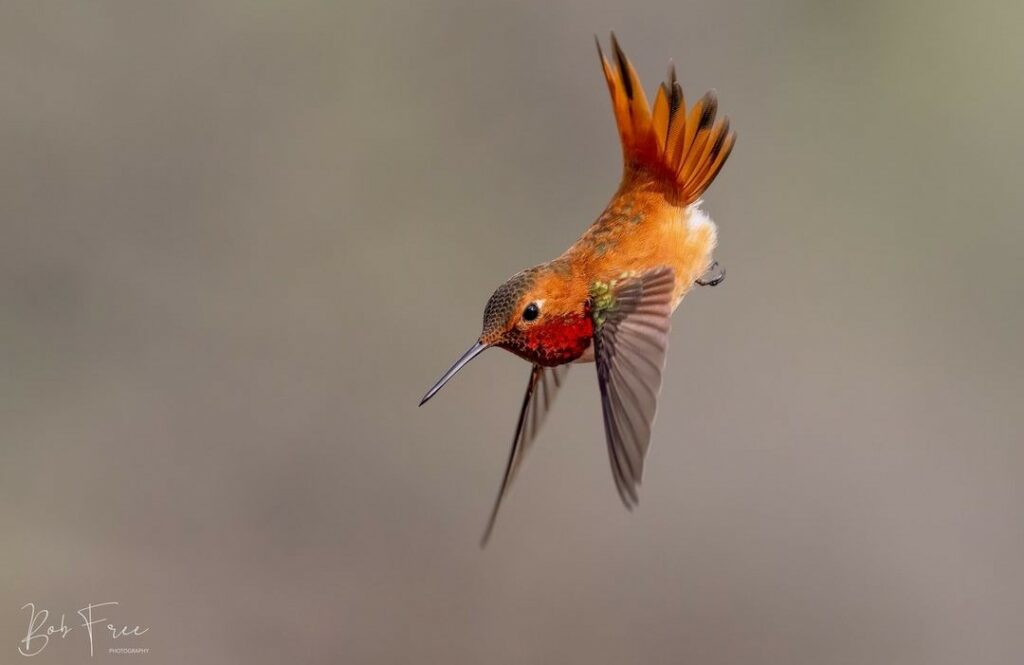
Photo by: Bob Free
It has even been observed that female mothers may attack squirrels and chipmunks that approach their nest too closely.
Due to their remarkable memory, Rufous hummingbirds have been observed to search for an abandoned hummingbird feeder years after it has been taken down.
Read my article: Hummingbird Adaptation and Remarkable Ability to Locate Food
Because of their unparalleled flying acrobatics, Rufous hummingbirds are fierce competitors at feeders, outmaneuvering all other species.
Rufous hummingbirds easily hybridize and cross-breed with other hummingbird species, such as Anna’s hummingbirds.
IUCN Red List classifies the Rufous hummingbird as “near threatened” because of habitat destruction in the Pacific Northwest.
In British Columbia, during a banding operation, the oldest living Rufous hummingbird was documented at 8 years and 10 months old.
Read my article: 3 Reasons Why Hummingbirds Are Banded
BROAD-TAILED HUMMINGBIRD – (Selsaphoris platycercus)
Conservation Status: Least concerned
Kingdom: Animalia
Phylum: Chordata
Class: Aves
Order: Apodiformes
Family: Trochilidae
Genus: Selsaphoris
Species: S. platycercus
The scientific name of the Broad-tailed hummingbird is Selasphorus platycercus. This species got its common name from the notably broad tail of the males, which is a distinguishing feature among hummingbirds.
This broad tail, when combined with the hummingbird’s flight patterns, creates a distinctive trilling sound that is also a characteristic of the species. The combination of visual and auditory traits played a significant role in the naming of this bird.
Male Broad-tailed hummingbirds:
An iridescent ruby-red gorget is seen on male Broad-tailed hummingbirds.
Males and females alike, the Broad-tailed hummingbird is characterized by its green upperparts, light underbelly, vivid white eye rings, and widely rounded tails.
They have a medium build, measure from 3.3 and 3.8 inches in length, and weigh 3.6 grams.
The metal plate that shields the wearer’s throat during combat to prevent injuries is the inspiration behind the name of the gorget on a male hummingbird.
This name is acceptable and fitting to characterize the physical characteristics of male hummingbirds, since they fight fiercely for their own territory.
Read my article: Hummingbird Gorgets Explained
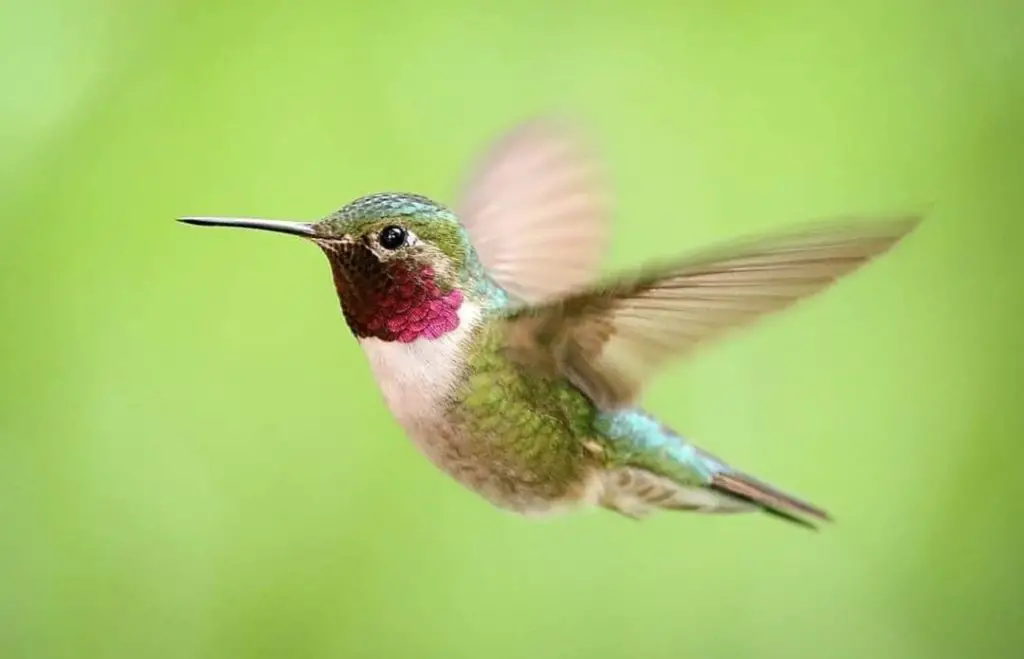
Photo by: bird.whisperer
Female Broad-tailed hummingbirds:
The female Broad-tailed hummingbird is less colorful than the male and lacks a gorget and iridescent feathers.
Their underbellies are pale to beige, with vivid white eye rings and broadly rounded tails.
Their topsides are green, extending from the head to the tail.
See my article: Hummingbird Parents: (Mating to Nesting)

Photo by: hummingbirdsbysuprise
Juvenile Broad-tailed hummingbirds:
Male and female juvenile Broad-tailed hummingbirds initially resemble adult females until the male starts to develop the iridescent feathers that are characteristic of this species of hummingbird.
Baby Broad-tailed hummingbirds:
Baby Broad-tailed hummingbirds are easily identified by their undertail coverts, which are white fluffy feathers near their bottom that will disappear as they age.
See my article: Baby Hummingbirds: (Egg to Fledgling)
To see the current sighting map of Nebraska’s Broad-tailed hummingbirds, click the link.
Hear the sounds of the Broad-tailed hummingbird (Cornell Lab of Ornithology link).
2.1% of all Nebraska hummingbird sightings will be Broad-tailed hummingbirds.
On average, out of 10,000 hummingbird sightings in Nebraska, only 213 will be a Broad-tailed hummingbird.
The Broad-tailed hummingbird travels frequently to the United States near the southern Mexican border.
They have a migrant and non-migrant population that begins in the south of Mexico. The ones that migrate north to breed will do so during spring migration and will pass through Arizona, Colorado, Wyoming, Idaho and reach as far north as Montana.
Once the breeding season is complete, Broad-tailed hummingbirds will depart and begin their southbound fall migration to winter in Mexico and meet up with their non-migrant population.
The Broad-tailed hummingbird favors habitats in the understory of mature forest woodlands such as pine and oak groves. They chose to nest on the branches of trees and have been known to return to the same nesting ground each year, roughly 70% of the time.
Their breeding time coincides with the peak time of flowering native plants for maximum food resource availability. Their favorite nectar-producing flower plants include Red Columbine, Indian Paintbrush, Sage varieties, Currants, and Scarlet Mint.
Broad-tailed hummingbirds hybridize and readily crossbreed with other hummingbird species, such as the Costa’s hummingbird.
In terms of social behavior, Broad-tailed hummingbirds are generally solitary, especially outside of the breeding season. They can be territorial, with males often defending prime feeding territories from other hummingbirds.
See my article: Why Hummingbirds Chase Each Other: Is it Friend or Foe?
The Broad-tailed hummingbird has suffered a decline in population since the 1990s, but presently, its population is stable, and it has been shown to have adapted to human habitat encroachment.
The oldest living Broad-tailed hummingbird, a female, was 12 years and 2 months, recorded during a capture and release banding operation in Colorado.
See my article: 3 Reasons Why Hummingbirds Are Banded
CALLIOPE HUMMINGBIRD – (Selasphorus calliope)
Conservation Status: Least concerned
Kingdom: Animalia
Phylum: Chordata
Class: Aves
Order: Apodiformes
Family: Trochilidae
Genus: Selasphorus
Species: S. calliope
Calliope hummingbirds are named after a Greek mythological muse, who represented poetry and eloquence. Calliope means “beautiful voice” in ancient Greek.
Male Calliope hummingbirds:
The long, stunning row of feathers that protrude down the sides of the throat and their iridescent purple cap are characteristics that make male Calliope hummingbirds clearly identifiable.
These hummingbirds, which are 3 inches long and weigh 2-3 grams, have shiny green backs like many others.
The metal plate that shields the wearer’s throat during combat to prevent injuries is the inspiration behind the name of the gorget on a male hummingbird.
This name is acceptable and fitting to characterize the physical characteristics of male hummingbirds, since they fight fiercely for their own territory.
Read my article: Hummingbird Gorgets Explained
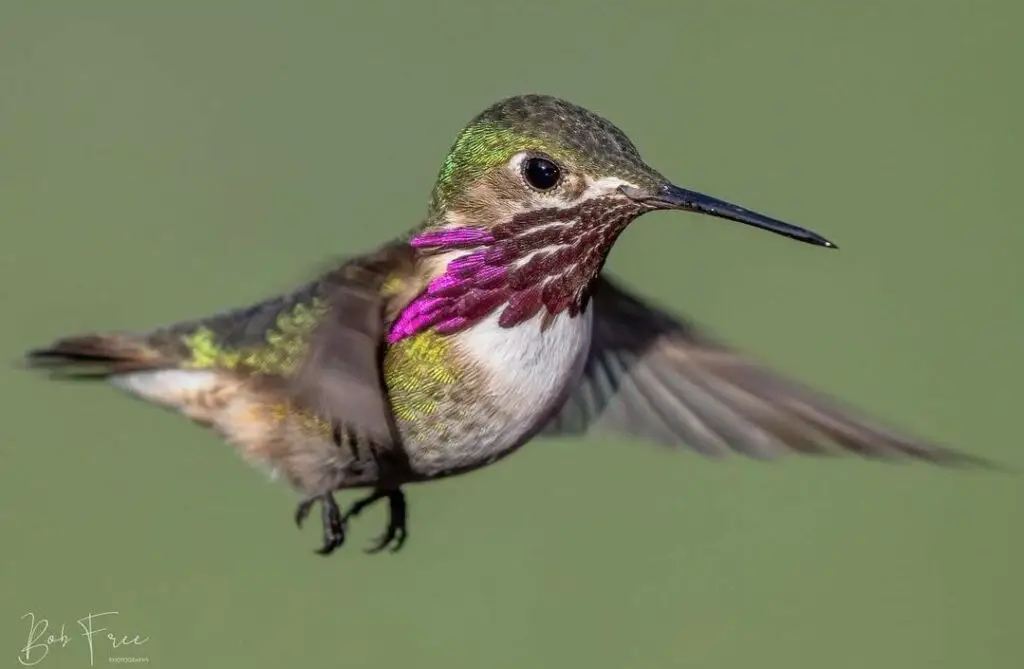
Photo by: Bob Free
Female Calliope hummingbirds:
The female Calliope hummingbird is less colorful than the male and lacks a gorget and iridescent feathers. Their head’s crown, or top, has a grayish-green hue.
The buff hue of the flanks refers to the sides, underbelly, and area beneath the wings.
See my article: Hummingbird Parents: (Mating to Nesting)

Photo by: sony_alpha_male

Photo by: Anthony Lujan
Juvenile Calliope hummingbirds:
Male and female juvenile Calliope hummingbirds initially resemble adult females until the male starts to develop the iridescent feathers that are characteristic of this species of hummingbird.
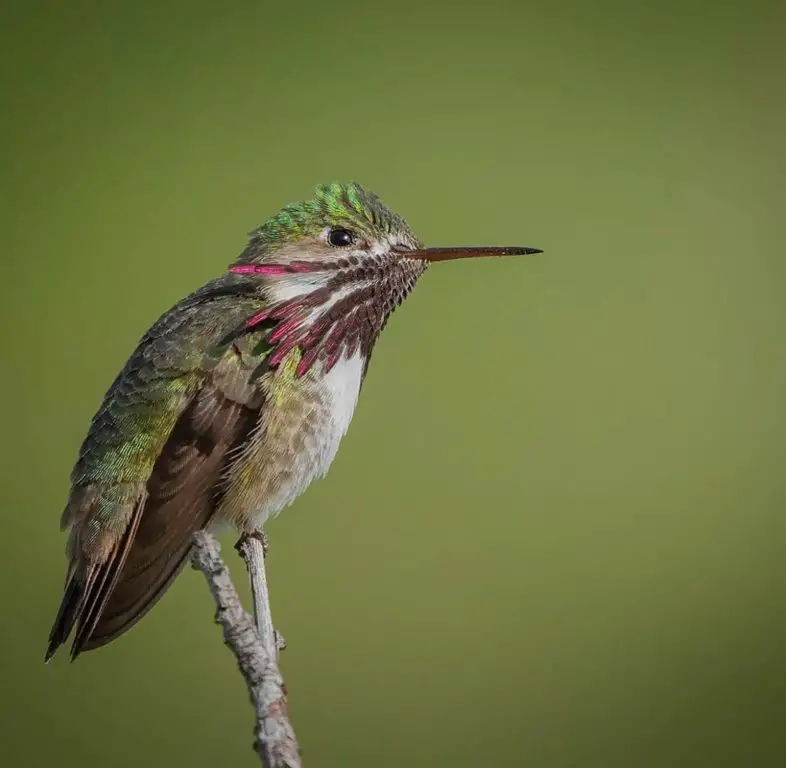
Photo by: sony_alpha_male
Note: His bright throat feathers are slowly coming in.
Baby Calliope hummingbirds:
Baby Calliope hummingbirds are easily identified by their undertail coverts, which are white fluffy feathers near their bottom that will disappear as they age.
See my article: Baby Hummingbirds: (Egg to Fledgling)
To see the current sighting map of the Calliope hummingbird in Nebraska, click the link.
Hear the sounds of the Calliope hummingbird (Cornell Lab of Ornithology link).
1.5% of all Nebraska hummingbird sightings will be Calliope hummingbirds.
On average, out of 10,000 hummingbird sightings in Nebraska, only 154 will be Calliope hummingbirds.
Like many other hummingbirds, Calliopes use their feathers to manipulate their flight path in order to produce a variety of buzzing noises that serve as a type of language.
The male will fervently fly back and forth and perform a “U” shaped courtship display to get the attention of the female when she is quietly perched.
He will perform a vocal serenade for the female while swaying his body back and forth in front of her.
See my article: Hummingbird Dance: 5 Interpretive Explanations
A breeding area is established by male Calliope hummingbirds, who mate with any female that accepts their wooing.
In terms of social behavior, Calliope hummingbirds are generally solitary, especially outside of the breeding season. They are territorial, with males often defending prime feeding territories from other hummingbirds.
See my article: Why Hummingbirds Chase Each Other: Is it Friend or Foe?
The world’s smallest long-distance migratory bird is the Calliope hummingbird. Their springtime migration patterns resemble those of Rufous hummingbirds.
Throughout their northward spring migration where they breed, they traverse the Pacific Flyways. On their southbound journey in the fall, they pass through the Pacific and Rocky Mountain Flyways towards their wintering destination in Mexico.
During the breeding season, female Calliope hummingbirds select the tips of pine cones as her building site for her nest. Along with stealing materials from other birds’ nests to build her own, she will also disassemble and recycle previous seasons’ nests.
Therefore, larger and more aggressive hummingbirds, such as Allen’s and Rufous hummingbirds, frequently chase and attack female Calliopes. Compared to other species, the Calliope keeps a low profile in order to evade these attacks.
Calliope hummingbirds hybridize and readily crossbreed with other hummingbird species, such as the Costa’s hummingbird.
Calliope hummingbirds are especially susceptible to habitat loss and natural catastrophes like wildfires and climate change because they have a smaller wintering range than other hummingbird species.
The oldest known female Calliope hummingbird was twice captured during a 2007 and 2014 banding operation in Idaho. She was 8 years and 11 months old at the time of her capture.
See my article: 3 Reasons Why Hummingbirds Are Banded
ANNA’S HUMMINGBIRD – (Calypte anna)
Conservation Status: Least concerned
Kingdom: Animalia
Phylum: Chordata
Class: Aves
Order: Apodiformes
Family: Trochilidae
Genus: Calypte
Species: C. anna
The Anna’s hummingbird, scientifically known as Calypte anna, gets its common name from Anna Masséna, the Duchess of Rivoli.
Male Anna’s hummingbirds:
In North America, male Anna’s hummingbirds are the only species of hummingbirds with a red crown. Their predominant colors are magenta, gray, and green.
The male gorget and crown are iridescent magenta, and they are very vivid and showy.
They weigh between 2.4 and 4.5 grams and have lengths ranging from 3.5 to 4.3 inches.
The metal plate that shields the wearer’s throat during combat to prevent injuries is the inspiration behind the name of the gorget on a male hummingbird.
This name is acceptable and fitting to characterize the physical characteristics of male hummingbirds, since they fight fiercely for their own territory.
Read my article: Hummingbird Gorgets Explained
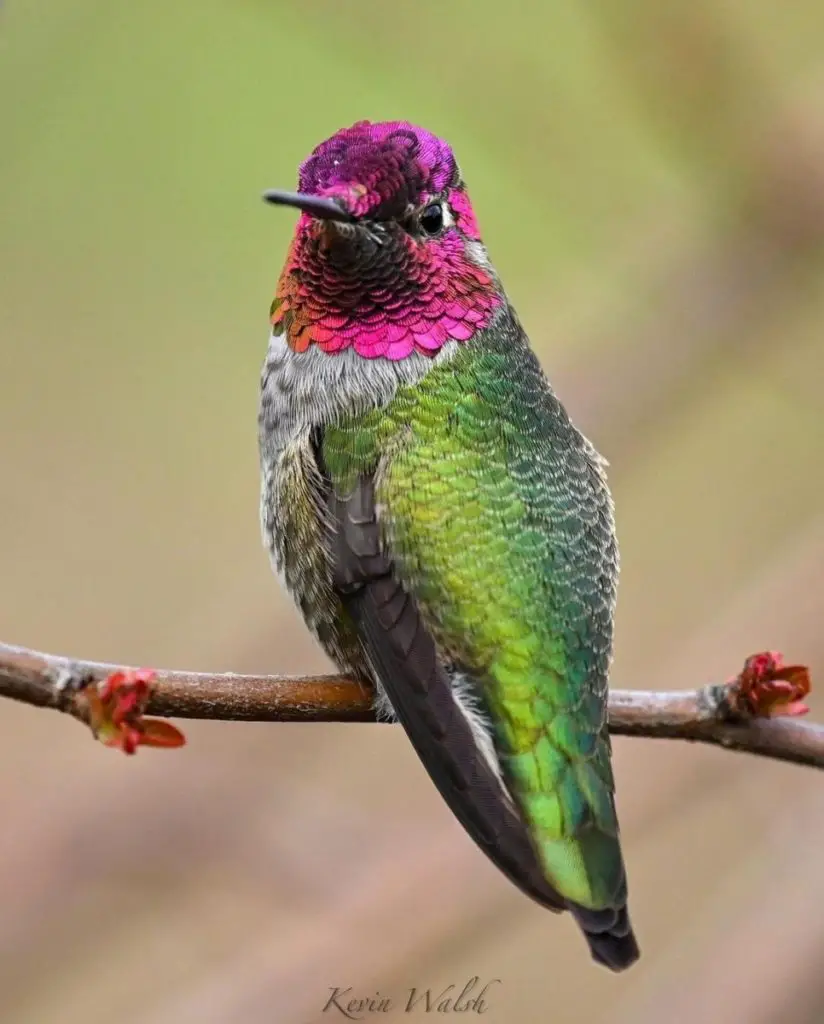
Photo by: Kevin Walsh
Note: The metallic green glossy back with iridescent magenta gorget and crown.
Female Anna’s hummingbirds:
Female Anna’s hummingbirds are pale green in hue, not as brilliant as the males.
Although a showy gorget is more prevalent on the males, females can also have them, showing a tiny area of magenta.
Females are identified by the faint white line that usually covers each eye.
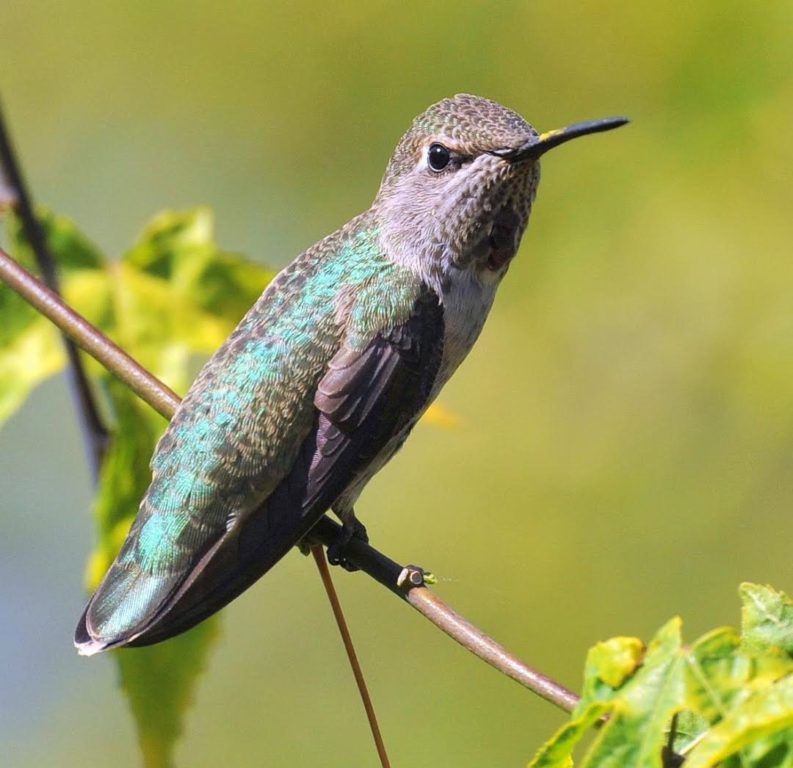
Photo by: IntheWildwithRick
Female Anna’s hummingbirds raise their young with no help from the males.
See my article: Hummingbird Parents: (Mating to Nesting)
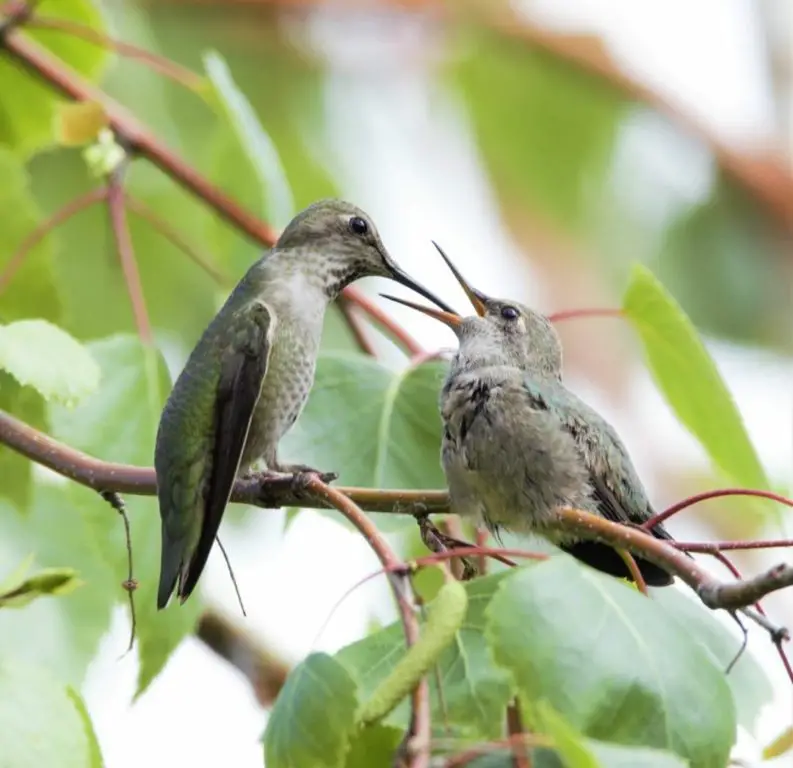
Photo by: Mehta.vishal.360
Juvenile Anna’s hummingbirds:
Juvenile Anna’s hummingbirds, both male and female, look more like adult females until they are differentiated as the male begins to acquire the bright red/magenta gorget.

Photo by: Kevin Walsh
Note: This Anna’s hummingbird may be a youngster going through the awkward adolescent years, or it may be in the process of molting.
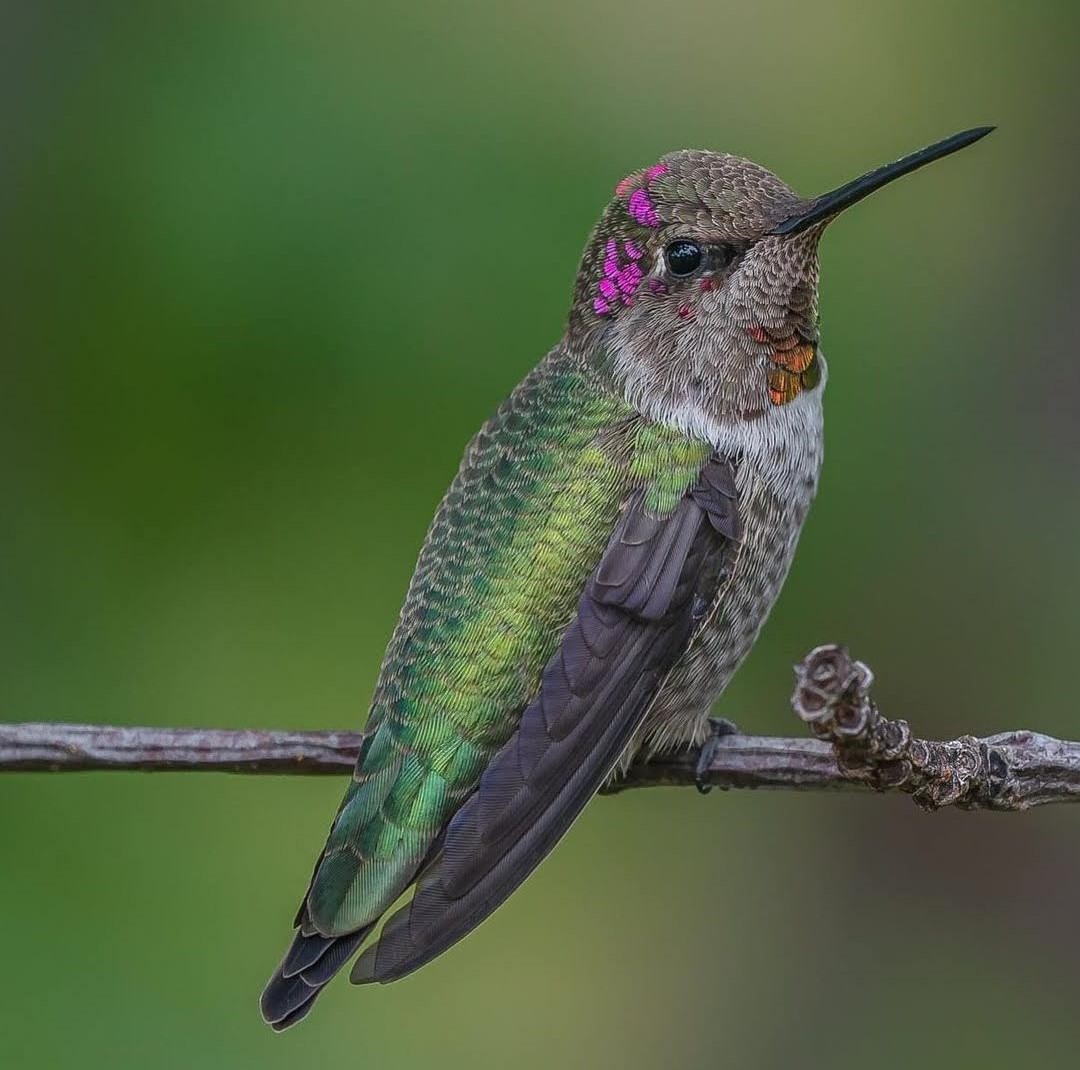
Photo by: Bob Free
Baby Anna’s hummingbirds:
Baby Anna’s hummingbirds are easily identified by their undertail coverts, which are white fluffy feathers near their bottom that will disappear as they age.
See my article: Baby Hummingbirds: (Egg to Fledgling)
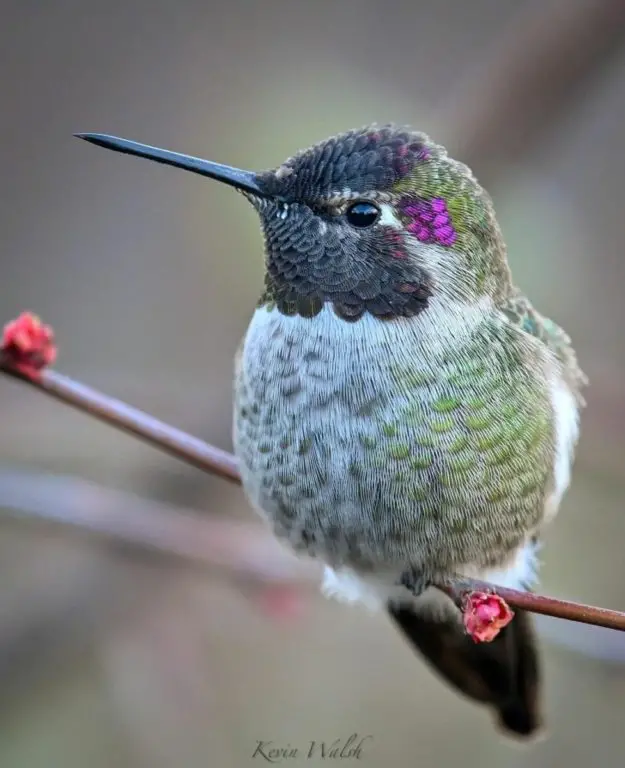
Photo by: Kevin Walsh
Note: The magenta head feathers of this baby/juvenile male Anna’s hummingbird are starting to show at his temple and a hint of color is beginning to appear on his gorget.
Also, notice the great fat reserves he has amassed from being fed by his vigilant mother and his newly white fluffy down feathers near his bottom.

Photo by: Kevin Walsh
To see the current sighting map of Nebraska’s Anna’s hummingbirds, click the link.
Hear the sounds of the Anna’s hummingbird (Cornell Lab of Ornithology link).
0.55% of all Nebraska hummingbird sightings will be Anna’s hummingbirds.
On average, out of 10,000 hummingbird sightings in Nebraska, 55 will be Anna’s hummingbirds.
The only hummingbird to reside year-round on the Pacific Coast, the Anna’s hummingbird is a native of the west coast of North America.
Anna’s hummingbirds enjoy a Mediterranean climate with hot, dry summers and fairly wet winters.
This species is a year-round resident in much of its range, unlike many other hummingbirds that migrate.
Male Anna’s are notable for their remarkable diving displays during mating season and their ability to thrive in urbanized areas.
The male Anna’s hummingbird executes dramatic and captivating displays during courtship and diving. The entire dive display lasts 12 seconds from start to finish.
See my article: Hummingbird Dance: 5 Interpretive Explanations
Unlike many northern temperate hummingbirds, male Anna’s hummingbirds sing during courtship along with making vibrations with their tail feathers to attract a female.
Anna’s hummingbirds hybridize and readily crossbreed with other hummingbird species, such as the Black-chinned, Costa’s, and Rufous hummingbirds.
Anna’s hummingbirds protect their territory with elaborate dives targeted towards predatory birds and even towards people they perceive to be threatening.
See my article: Why Hummingbirds Chase Each Other: Is it Friend or Foe?
Many Nebraska hummingbird admirers leave hummingbird feeders up all winter long to provide life-nourishing nectar to the most commonly seen residents: the Anna’s and Rufous hummingbirds.
This selfless act also provides nectar to other injured or older hummingbirds that are unable to migrate.
See my article: 11 DIY Ways to Keep Hummingbird Nectar From Freezing
The oldest male Anna’s hummingbird known to exist was 8 years and 2 months old when he was captured and released during a banding expedition in Arizona.
See my article: 3 Reasons Why Hummingbirds Are Banded
BLACK-CHINNED HUMMINGBIRD – (Archilochus alexandri)
Conservation Status: Least concerned
Kingdom: Animalia
Phylum: Chordata
Class: Aves
Order: Apodiformes
Family: Trochilidae
Genus: Archilochus
Species: A. alexandri
The Black-chinned hummingbird’s scientific name is in commemoration of Dr. Alexandre, a French doctor who was the first to discover the species in Mexico.
Male Black-chinned hummingbirds:
The royal purple gorget resembling a buttoned-up shirt with a small flash of color right near the neckline is the distinguishing feature of male Black-chinned hummingbirds.
The male’s purple gorget or throat in some lighting at times looks entirely black.
Their flanks and backs are metallic green, while their undersides are white. They have a black bill and a forked dark tail.
Their length ranges from 3.25 to 3.5 inches, and they weigh between 2.8 and 5.6 grams.
The metal plate that shields the wearer’s throat during combat to prevent injuries is the inspiration behind the name of the gorget on a male hummingbird.
This name is acceptable and fitting to characterize the physical characteristics of male hummingbirds, since they fight fiercely for their own territory.
Read my article: Hummingbird Gorgets Explained
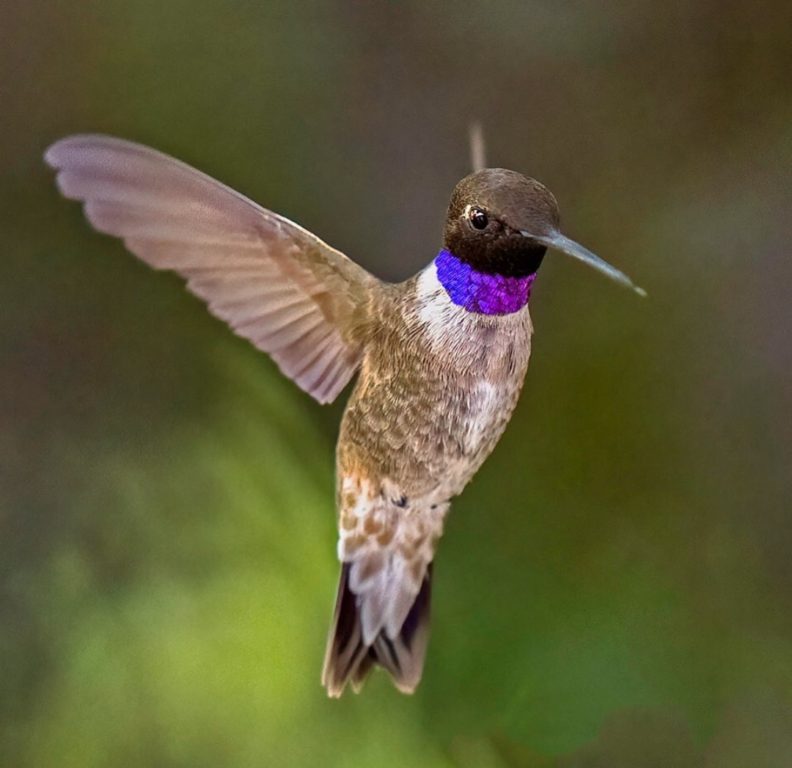
Photo by: sony_alpha_male
Female Black-chinned hummingbirds:
Compared to their male counterparts, female Black-chinned hummingbirds are less colorful and lack a gorget and iridescent feathers.
White tips and beige edges on the dorsal feathers, which turn dark black as they age, adorn their dark, rounded tail, which has a white underbelly.
They have dull metallic marbled colors on their head and backs that resemble snake scales: beige, green, white, yellow-green, and dark brown.
Read my article: Hummingbird Parents: (Mating to Nesting)
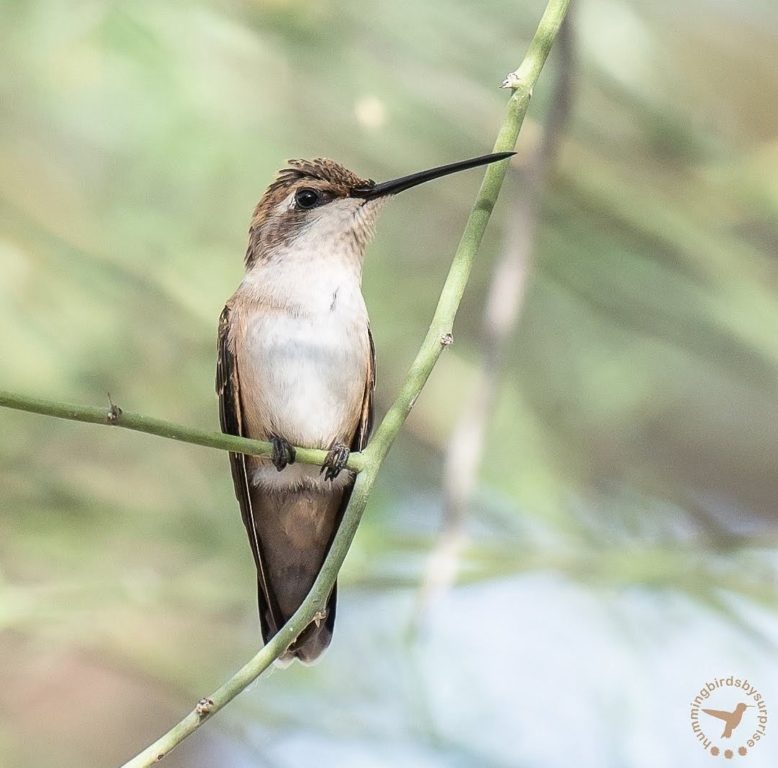
Photo by: hummingbirdsbysurpise
Juvenile Black-chinned hummingbirds:
Male and female juvenile Black-chinned hummingbirds initially resemble adult females until the male starts to develop the iridescent feathers that are characteristic of this species of hummingbird.
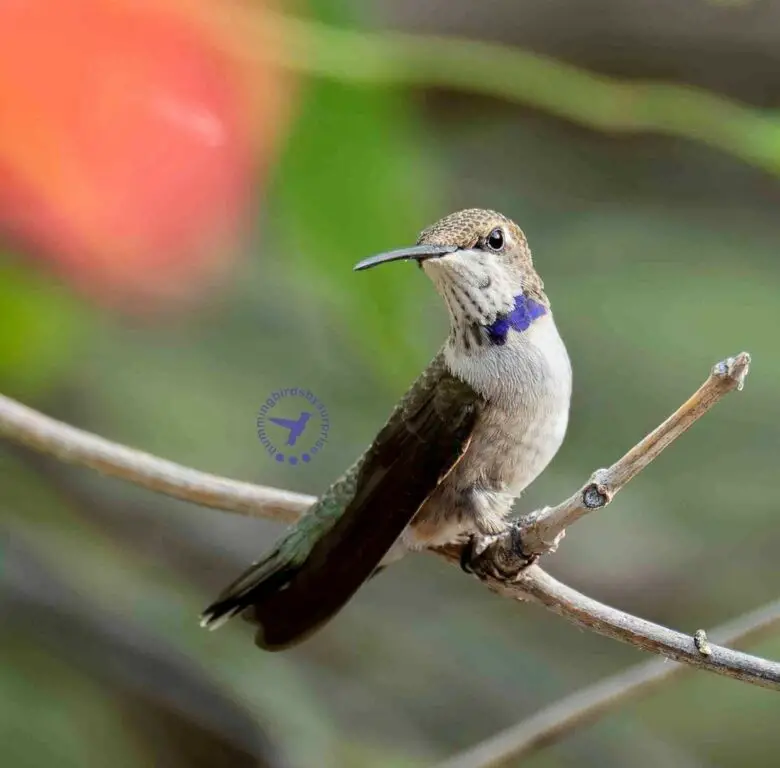
Photo by: hummingbirdsbysuprise
Baby Black-chinned hummingbirds:
Baby Black-chinned hummingbirds are easily identified by their undertail coverts, which are white fluffy feathers near their bottom that will disappear as they age.
See my article: Baby Hummingbirds: (Egg to Fledgling)
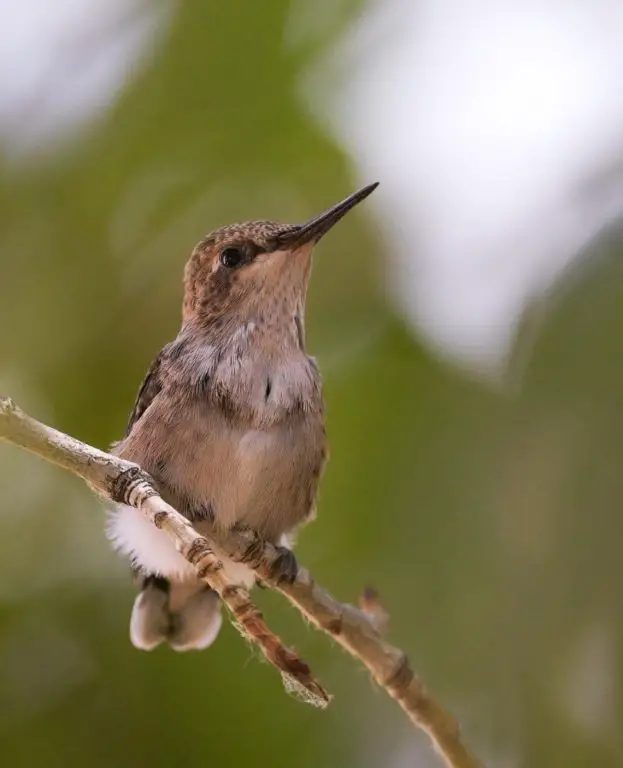
Photo by: bird.whisperer
To see the current sighting map of the Black-chinned hummingbird in Nebraska, click the link.
Hear the sounds of the Black-chinned hummingbird (Cornell Lab of Ornithology link).
0.54% of all Nebraska hummingbird sightings will be Black-chinned hummingbirds.
On average, out of 10,000 hummingbird sightings in Nebraska, only 54 will be Black-chinned hummingbirds.
Black-chinned hummingbirds breed to the east of the Cascade mountain range. By employing a decoy tactic, they are known to build their nests close to larger, busier bird nests, hence decreasing the likelihood of predators nearby.
Of all extant mammals or vertebrates, Black-chinned hummingbirds have the least amount of genetic material known to science. Due to their little size, they run the risk of becoming prey for larger birds that consume insects.
See my article: 10 Common Things That Kill Hummingbirds
Particularly while protecting “their” feeders, hummingbirds come across as the most ruthless sheriff in the area due to their intense territoriality. To defend nectar sources full of blooming plants that attract hummingbirds, they will engage in territorial conflicts.
Although Black-chinned hummingbirds are a territorial species, they will become less aggressive and learn to share if they happen to be in an area with a high hummingbird population and food sources.
See my article: Why Hummingbirds Chase Each Other: Is it Friend or Foe?
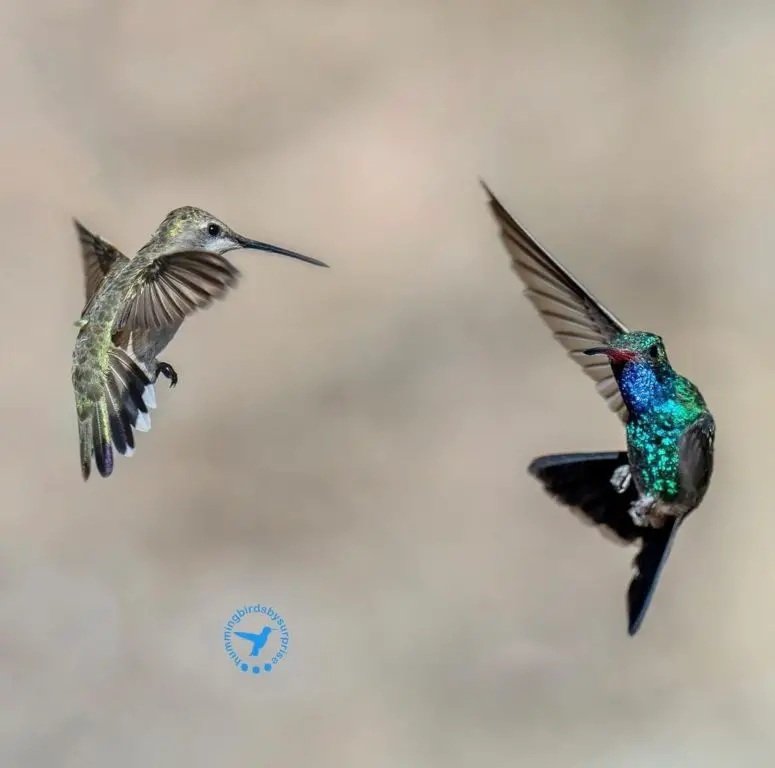
Photo by: hummingbirdsbysuprise
The lifespan of a Black-chinned hummingbird is an astounding ten years, compared to other animals and birds of comparable size.
Black-chinned hummingbirds easily hybridize and interbreed with other hummingbird species, including Costa’s and Anna’s.
In Texas, during a banding and capture effort, the oldest known female Black-chinned hummingbird was 11 years and 2 months old.
See my article: 3 Reasons Why Hummingbirds Are Banded
COSTA’S HUMMINGBIRD – (Calypte costae)
Conservation Status: Least concerned
Kingdom: Animalia
Phylum: Chordata
Class: Aves
Order: Apodiformes
Family: Trochilidae
Genus: Calypte
Species: C. costae
The scientific name of the Costa’s hummingbird is Calypte costae.
Jules Bourcier named the Costa’s hummingbird in 1839 in honor of Louis Marie Pantaleon Costa, a French naturalist, and ardent hummingbird collector. He was recognized for his contributions to the field, and thus, the bird was named in his honor.
This practice of naming species after people, especially those who have made significant contributions to science or natural history, is quite common in taxonomy.
Male Costa’s hummingbirds:
The male Costa’s hummingbird is a small and vibrant bird, easily recognizable by its distinct coloration and features.
It possesses a bright reddish-purple cap, which covers the head feathers, and a similarly colored gorget, which is the area around the throat.
Unique to this species, the gorget displays long streaming throat feathers that extend on both sides of its face, bearing a resemblance to the feather arrangement found in Calliope hummingbirds.
The metal plate that shields the wearer’s throat during combat to prevent injuries is the inspiration behind the name of the gorget on a male hummingbird.
This name is acceptable and fitting to characterize the physical characteristics of male hummingbirds, since they fight fiercely for their own territory.
Read my article: Hummingbird Gorgets Explained
In contrast to the vivid colors of its head and throat, the male Costa’s hummingbird has a subdued body coloration. Its underbelly is light greenish-gray, providing a soft counterbalance to the brilliance of its head.
The back and flanks of the bird display a green hue, seamlessly blending with its natural habitats.
Regarding its size, the male Costa’s hummingbird is relatively small, measuring between 3 to 3.5 inches in length, and is lightweight, tipping the scales at just 2 to 3 grams.
This combination of striking head and throat colors with its more muted body tones makes the male Costa’s hummingbird a distinctive and easily identifiable species among hummingbirds.
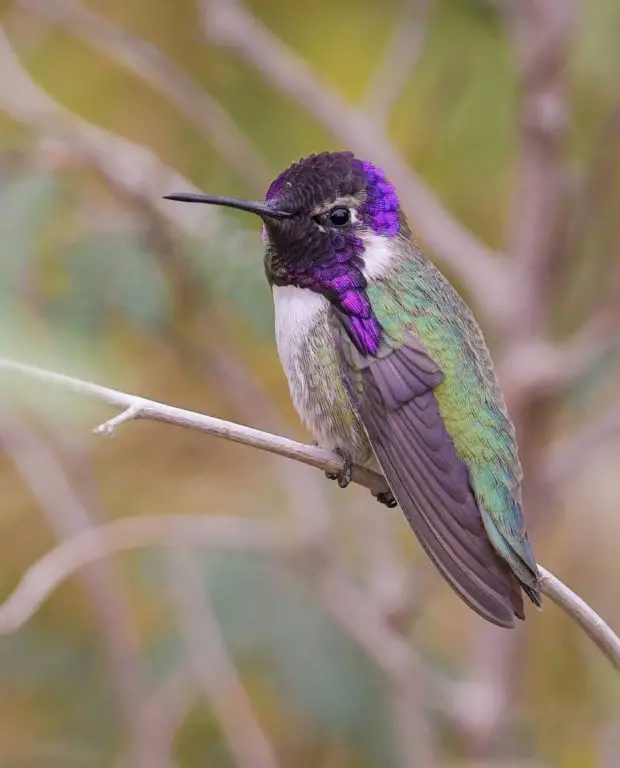
Photo by: bird.whisperer
Female Costa’s hummingbirds:
The female Costa’s hummingbird presents a more subdued appearance compared to the strikingly vibrant males. Lacking the iridescent feathers that characterize their male counterparts, female Costa’s hummingbirds display a more understated coloration.
Their grayish-light-green back is a muted hue that blends easily with the environment. This coloring provides excellent camouflage, especially in the bird’s natural habitats.
The underbelly is a dusty white, further contributing to their less conspicuous appearance. This contrast between the slightly darker back and the lighter underbelly, while subtle, still offers a distinctive look within the species.
The absence of the bright colors and iridescent feathers found in males is a common trait in many bird species, where females often have more subdued coloration, possibly as an evolutionary adaptation for better concealment while nesting and raising young.
See my article: Hummingbird Parents: (Mating to Nesting)

Photo By: Aaron Gomperts
Female Costa’s hummingbirds migrate north from Mexico to breed in Arizona, California, Nevada, and Utah.
Being a desert-dwelling species, Costa’s hummingbirds nest in open spaces with little vegetation. It has been observed that they build their nests on cacti. Predators that might try to consume the eggs or nestlings are discouraged from doing so by the plant’s thorns.
Read my article: 10 Common Things That Kill Hummingbirds
Juvenile Costa’s hummingbirds:
Both male and female juvenile Costa’s hummingbirds look more like adult females until they are differentiated as the male begins to acquire the iridescent feathers that are typical for males of this species of hummingbird.
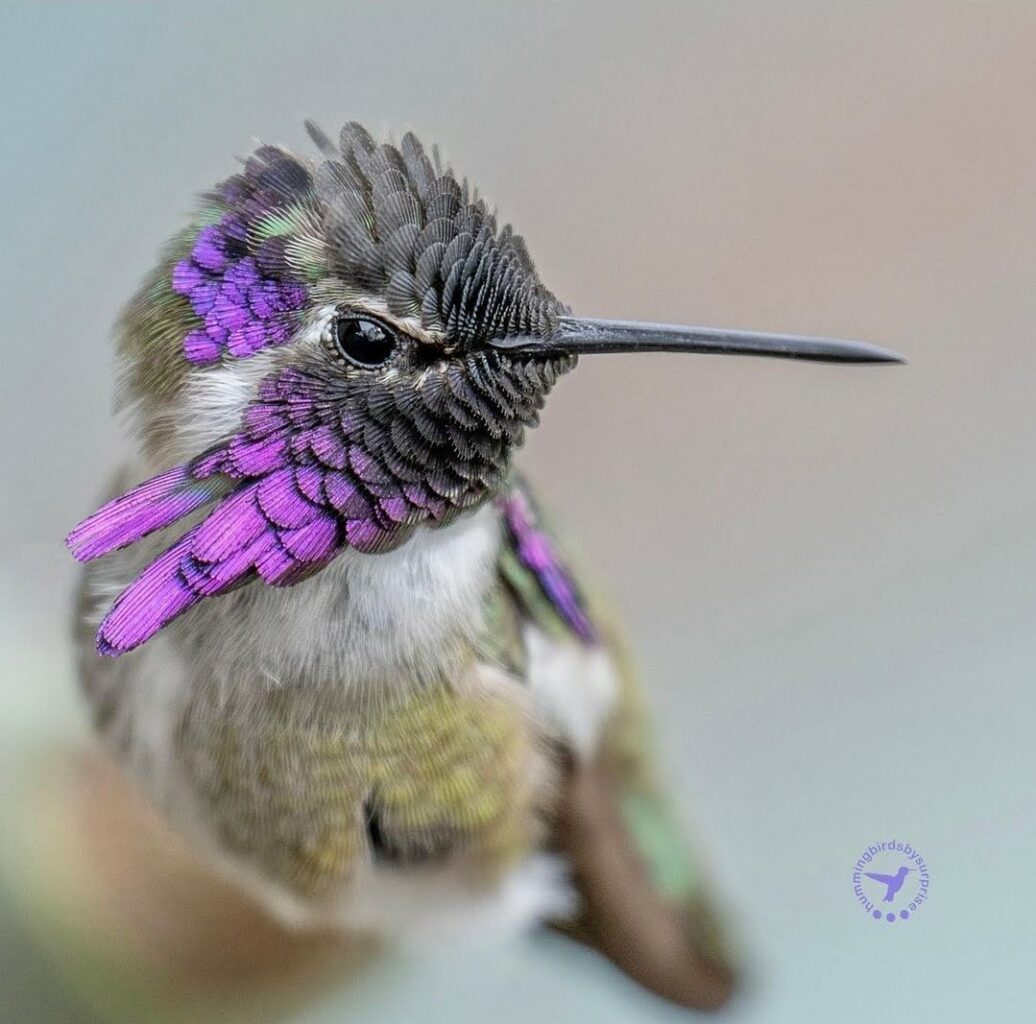
Photo by: hummingbirdbysuprise
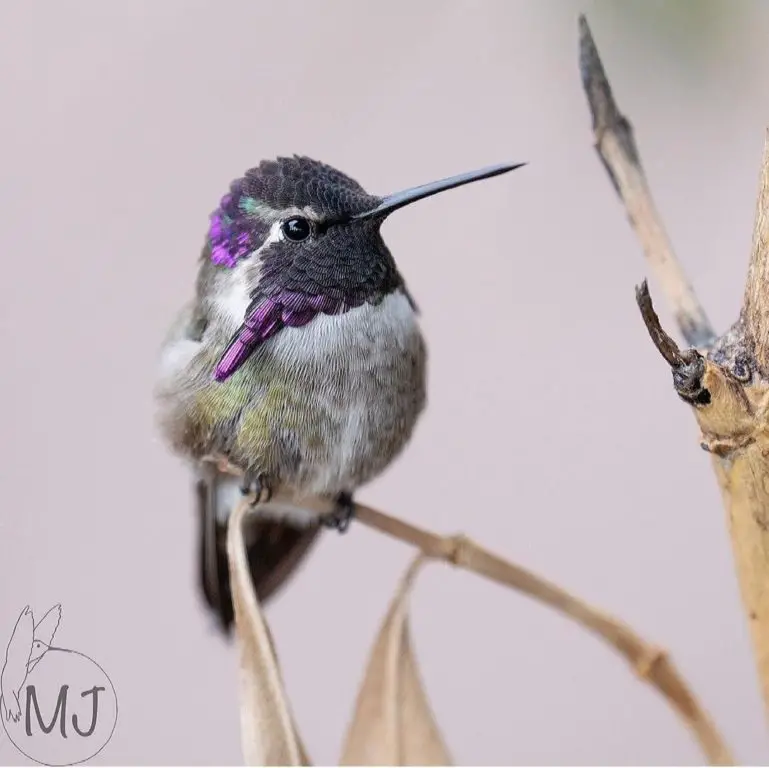
Photo by: hummingbirdsbysuprise
Note: His bright throat feathers are slowly coming in.
Baby Costa’s hummingbirds:
Baby Costa’s hummingbirds are easily identified by their undertail coverts, which are white fluffy feathers near their bottom that will disappear as they age.
See my article: Baby Hummingbirds: (Egg to Fledgling)

Photo by: hummingbirdbysuprise
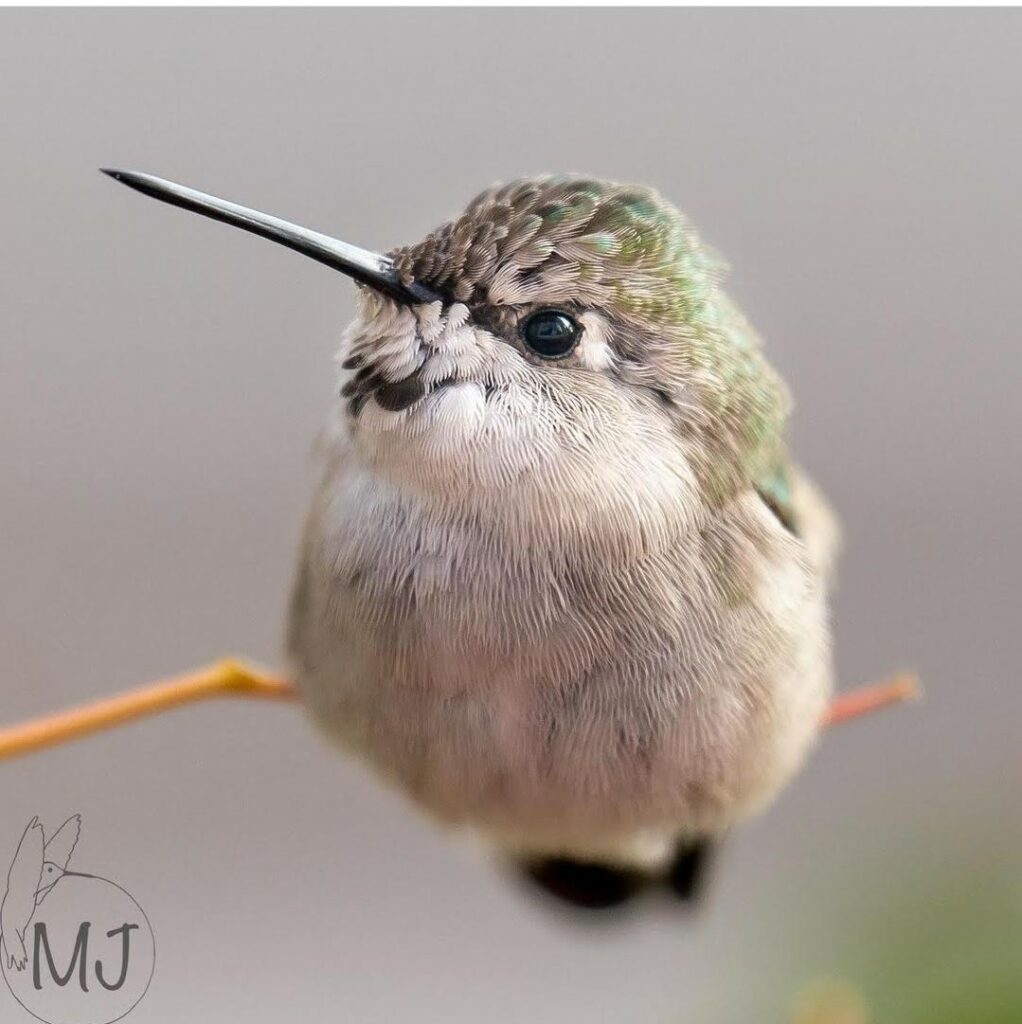
Photo by: hummingbirdsbysuprise
To see the current sighting map of Nebraska’s Costa’s hummingbirds, click the link.
Hear the sounds of the Costa’s hummingbird (Cornell Lab of Ornithology link).
0.11% of all Nebraska hummingbird sightings will be Costa’s hummingbirds. hummingbirds.
On average, out of 10,000 hummingbird sightings in Nebraska, only 11 will be Costa’s hummingbirds.
Very little is known about Costa’s hummingbirds and their short migratory habits in comparison to other hummingbird species.
Costa’s hummingbirds are primarily found in arid and semi-arid environments, including deserts, scrublands, and chaparral regions.
Living in dry habitats, Costa’s hummingbirds have developed adaptations to survive in these conditions. They are efficient in their water usage and can tolerate higher temperatures than many other bird species.
Their choice of flowering plants also reflects their adaptation to their environment, often favoring those that thrive in arid conditions.
They are native to the southwestern United States and Baja California in Mexico, often found in areas with abundant flowering plants which are crucial for their survival.
In terms of social behavior, Costa’s hummingbirds are generally solitary, especially outside of the breeding season. They can be territorial, with males often defending prime feeding territories from other hummingbirds.
See my article: Why Hummingbirds Chase Each Other: Is it Friend or Foe?
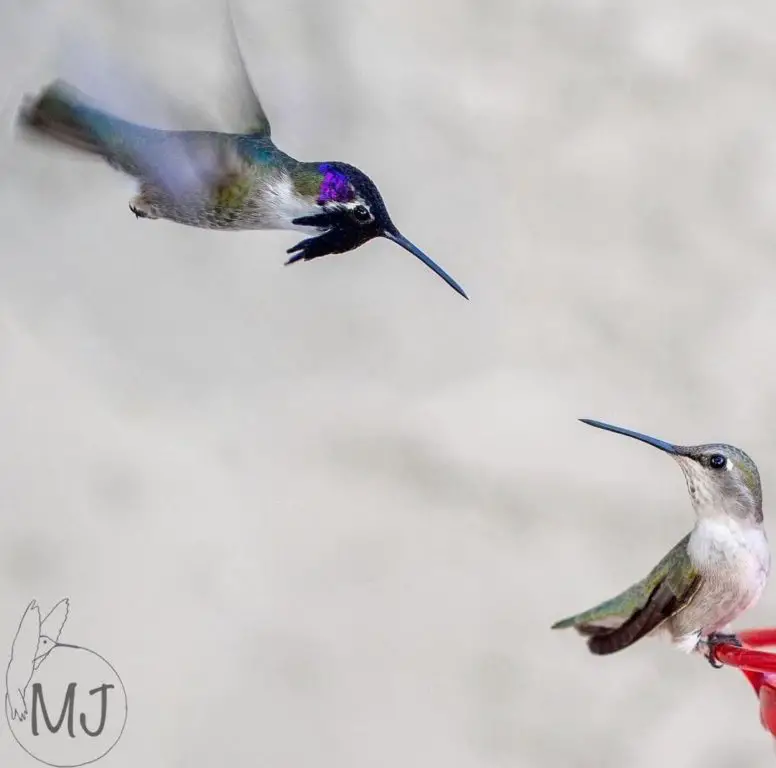
Photo by: hummingbirdsbysuprise
Although Costa’s hummingbirds will defend nectar sources amongst themselves, they are subordinate to larger hummingbirds and will defer to them if challenged.
The Costa’s hummingbird is a partially migratory species. During the winter, birds in the northern portion of their range—especially those found in the United States—usually migrate southward to warmer climes. People in the southern portion of their range, particularly in Mexico, are frequently non-migratory.
Costa’s hummingbirds are known to interbreed or cross-breed, producing hybrids between Anna’s, Black-chinned, Blue-throated, Broad-tailed, and Calliope hummingbirds.
The biggest danger facing Costa’s hummingbirds is human encroachment, which takes the shape of plowed desert areas cleared for habitation and grazing.
The oldest known female Costa’s hummingbird lived for 8 years and 9 months after being caught and released twice during a banding operation in California in 2001 and 2009.
See my article: 3 Reasons Why Hummingbirds Are Banded
BROAD-BILLED HUMMINGBIRD – (Cynanthus latirostris)
Conservation Status: Least concerned
Kingdom: Animalia
Phylum: Chordata
Class: Aves
Order: Apodiformes
Family: Trochilidae
Genus: Cynanthus
Species: C. latirostris
The Broad-billed hummingbird, scientifically named Cynanthus latirostris, is known for its distinctive broad bill, which is the origin of its common name.
Their broad bills are particularly adapted for feeding on a variety of flowers.
Although most of the population of Broad-billed hummingbirds remains in Mexico and Central America throughout the year, they are a Mexican species that regularly visits the United States close to the southern Mexican border.
Male Broad-billed hummingbirds:
The brilliant blue-green gorget of male Broad-billed hummingbirds stretches back towards their shoulders. They have a long, brilliant orange-red beak with a distinctive black tip.
Their length varies from 3.25 to 4 inches, and they weigh between 3 and 4 grams.
The metal plate that shields the wearer’s throat during combat to prevent injuries is the inspiration behind the name of the gorget on a male hummingbird.
This name is acceptable and fitting to characterize the physical characteristics of male hummingbirds, since they fight fiercely for their own territory.
Read my article: Hummingbird Gorgets Explained
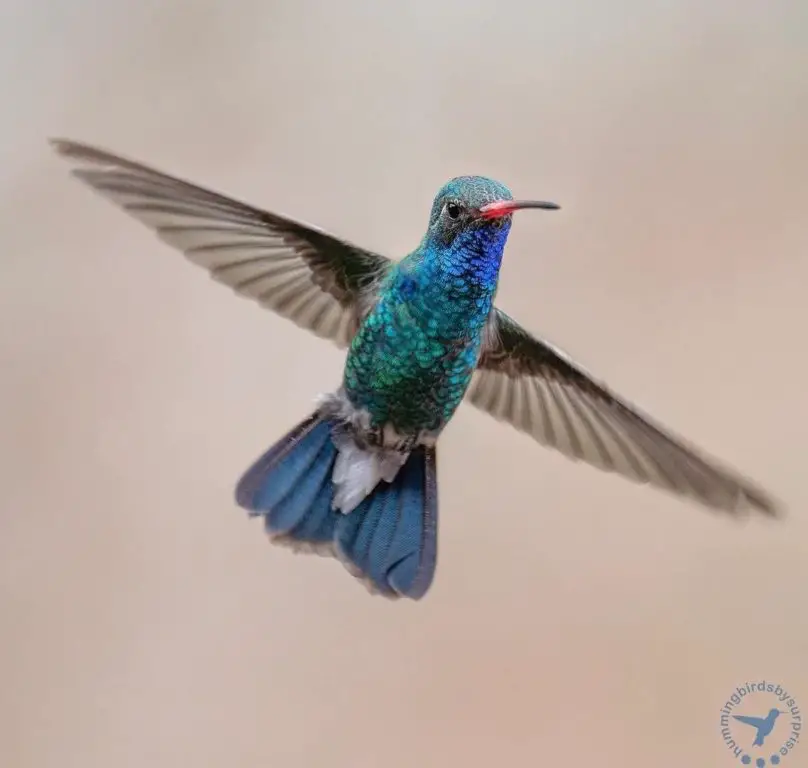
Photo by: hummingbirdsbysuprise
Female Broad-billed hummingbirds:
Generally speaking, female Broad-billed hummingbirds lack iridescent feathers and have a duller appearance than males.
Their bill is entirely black, with a larger white accent over their eyes. They are recognized by their mainly metallic green upperparts and white undersides.
Their tails are forked and have a black tint.
Juvenile Broad-billed hummingbirds:
Male and female juvenile Broad-billed hummingbirds initially resemble adult females until the male starts to develop the iridescent feathers that are characteristic of this species of hummingbird.
Male juveniles display a full charcoal dark gray body, a light green neck and backside with flecks of metallic blue on their throat.
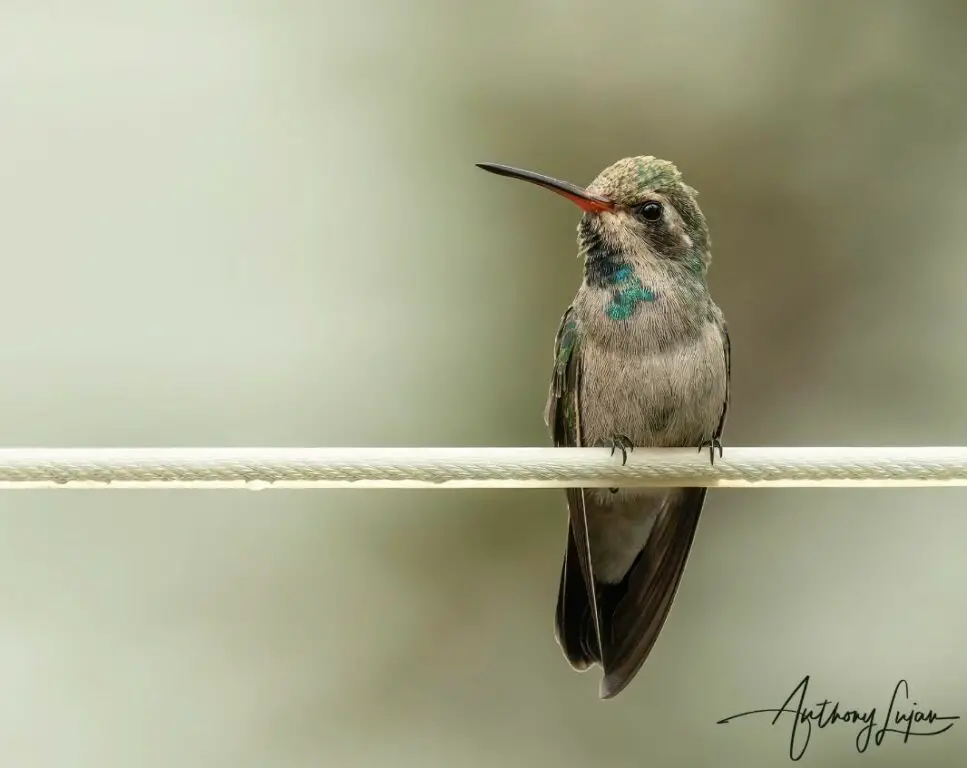
Photo by: Anthony Lujan
Baby Broad-billed hummingbirds:
Baby Broad-billed hummingbirds are easily identified by their undertail coverts, which are white fluffy feathers near their bottom that will disappear as they age.
See my article: Baby Hummingbirds: (Egg to Fledgling)

Photo by: hummingbirdsbysuprise
To see the current sighting map of Nebraska’s Broad-billed hummingbirds, click the link.
Hear the sounds of the Broad-billed hummingbird (Cornell Lab of Ornithology link).
0.03% of all Nebraska hummingbird sightings will be Broad-billed hummingbirds.
On average, out of 10,000 hummingbird sightings in Nebraska, only 3 will be Broad-billed hummingbirds.
Broad-billed hummingbirds are native to the southwestern United States, Mexico, and down into Central America.
They prefer habitats such as canyons, riverine woodlands, and sometimes gardens or urban areas with suitable flowering plants.
Nests made by Broad-billed hummingbirds are identified by their lack of lichen decoration on the exterior.
Instead, the birds prefer to build their nests utilizing outside grass fibers, leaf fragments, and bark, and then utilize spider webs to secure and maintain the structure of the nest.
The female constructs a nest that is suspended from a single, long, thin branch.
See my article: Hummingbird Parents: (Mating to Nesting)
Particularly while defending “their” feeders, Broad-billed hummingbirds come across as the meanest sheriff in the community due to their intense territoriality.
They will engage in territorial conflicts to defend nectar sources that are home to blooming plants that attract hummingbirds.
See my article: Why Hummingbirds Chase Each Other: Is it Friend or Foe?

Photo by: Anthony Lujan
Surprisingly, the Broad-billed hummingbird has demonstrated a real overall population growth in recent years, in contrast to other hummingbird population surveys.
The future of the Broad-billed hummingbird, like many wildlife species, depends on the preservation of their habitats and understanding the impacts of environmental changes.
Conservation efforts and responsible practices in gardening and feeder maintenance can aid in their survival.
When the oldest male Broad-billed hummingbird was caught and released in Arizona during a banding operation, he was 9 years and 1 month old.
See my article: 3 Reasons Why Hummingbirds Are Banded
Top Google-ranked websites recognize one additional hummingbird, the Allen’s hummingbird, as a Nebraska hummingbird, despite the fact there are just eight species recorded as being seen in Nebraska on a national hummingbird sighting map.
ALLEN’S HUMMINGBIRD – (Selasphorus sasin)
Conservation Status: Least concerned
Kingdom: Animalia
Phylum: Chordata
Class: Aves
Order: Apodiformes
Family: Trochilidae
Genus: Selasphorus
Species: S. sasin
The scientific name of the Allen’s hummingbird is Selasphorus sasin.
The common name of the Allen’s hummingbird is in commemoration of Charles Andrew Allen (1841-1930), an American collector and taxidermist.
Male Allen’s hummingbirds:
Male Allen’s hummingbirds are green-backed with a green forehead and rust-colored flanks, rump, and tail. When their tail feathers are fanned out you can see their chocolate-colored tips.
The gorget of the male Allen’s hummingbird is an iridescent orange-red, however, in darker lighting, it can appear chocolate brown.
Allen’s hummingbirds are 3.3 inches to 3.5 inches in length and weigh 2-4 grams.The metal plate that shields the wearer’s throat during combat to prevent injuries is the inspiration behind the name of the gorget on a male hummingbird.
This name is acceptable and fitting to characterize the physical characteristics of male hummingbirds, since they fight fiercely for their own territory.
Read my article: Hummingbird Gorgets Explained
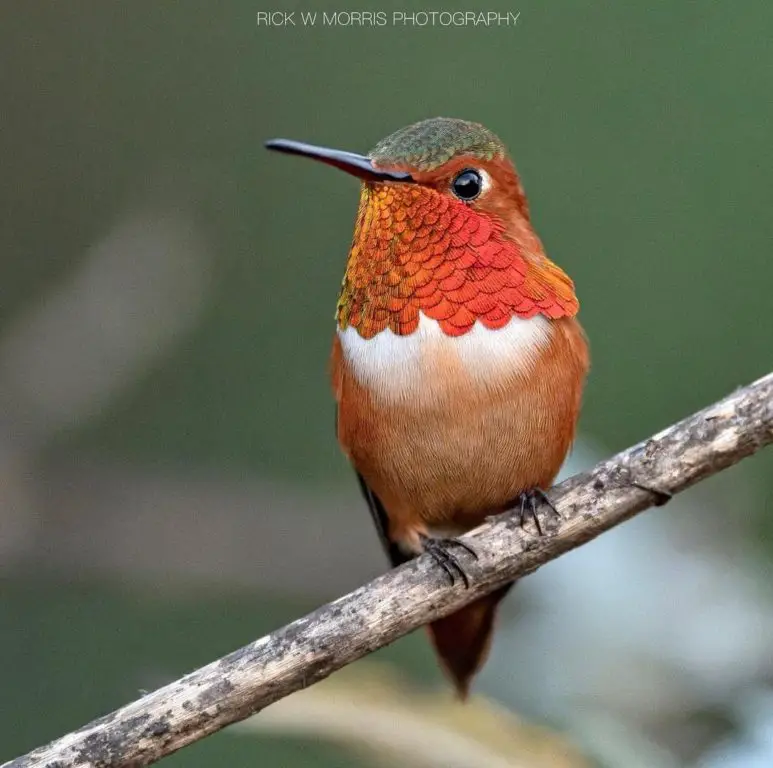
Photo by: IntheWildwithRick
Female Allen’s hummingbirds:
The female Allen’s hummingbird is less colorful than the male because it lacks the iridescent gorget.

Photo by: Aaron Gomperts
In the wild, confusion may arise because certain females have stippling or color specs along their throat lines that resemble juvenile characteristics.
See my article: Hummingbird Parents: (Mating to Nesting)
See my article: Baby Hummingbirds: (Egg to Fledgling)
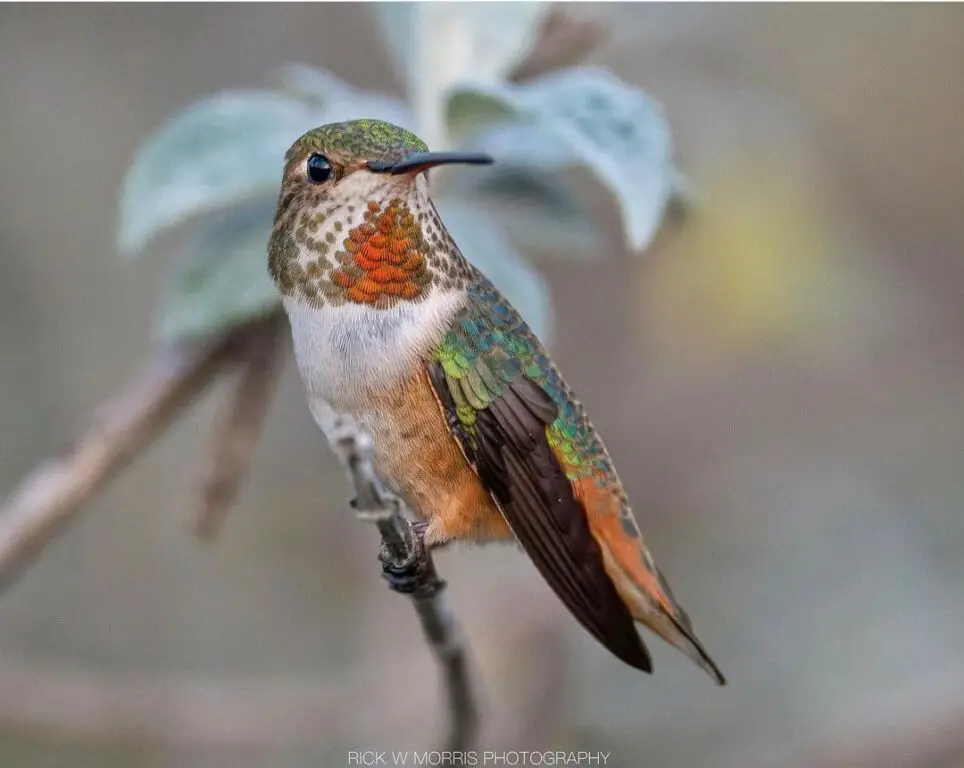
Photo by: IntheWildwithRick
Juvenile Allen’s hummingbirds:
Both male and female juvenile Allen’s hummingbirds first resemble adult females until the male starts to develop the characteristic iridescent feathers of this species of hummingbird.
In the field, they are nearly identical to Rufous hummingbirds due to their striking similarity in colors and disposition.
Therefore, range rather than appearance is used to establish identity.

Baby Allen’s hummingbirds:
Baby Allen’s hummingbirds are easily identified by their undertail coverts, which are white fluffy feathers near their bottom that will disappear as they age.
See my article: Baby Hummingbirds: (Egg to Fledgling)
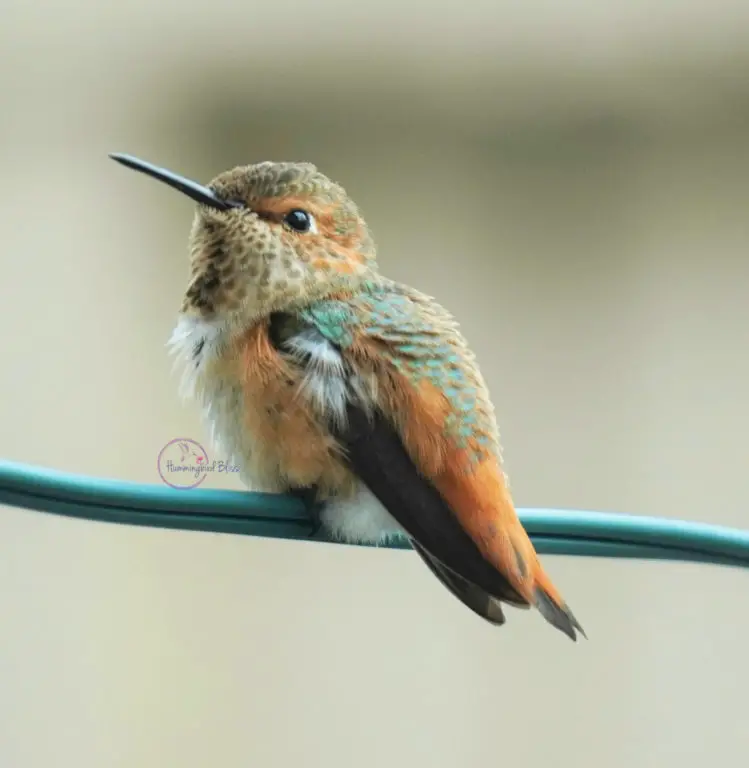
Note: He is guarding a neighboring feeder with diligence. Observe the developmental differences between the juvenile in the last shot on the tomato cage and the current photo on the outside light wire.
They both have fluffy white feathers near their bottoms, yet there is a noticeable age difference between youth and maturity.
To see the current sighting map of Nebraska’s Allen’s hummingbirds, click the link.
Hear the sounds of the Allen’s hummingbird (Cornell Lab of Ornithology link).
Male Allen’s hummingbirds engage in a dramatic, fast-paced courtship dance that mimics a pendulum’s swing. Of all the hummingbirds in North America, their territorial dive displays are among the most intricate.
See my article: Hummingbird Dance: 5 Interpretive Explanations
Allen’s hummingbirds, both male and female, are gregarious birds. Other than mating, they do not interact with each other.
They are fiercely territorial and hostile toward other hummingbirds as well as larger predatory birds like hawks, much like Rufous hummingbirds.
Allen’s hummingbirds are primarily found in coastal parts of California and Oregon, USA. They prefer habitats like gardens, forested or shrubby areas, and coastal chaparral.
They migrate to southern Mexico in the winter, covering quite long distances for such small birds.
Allen’s hummingbirds are highly territorial, especially the males during the breeding season. They engage in aggressive aerial displays to defend their feeding territories from intruders. These displays include high-speed chases and intricate flight patterns.
See my article: Why Hummingbirds Chase Each Other: Is it Friend or Foe?
Allen’s hummingbirds commonly reside and nest along the west coast and winter in Mexico. Their nesting season is perfectly timed with when the regions have the most rainfall which helps provide prolific nectar producing flowers for their offspring.
Usually found in trees or shrubs, females use plant materials and spider webs to construct tiny, cup-shaped nests. Each time they attempt to reproduce, they lay one to two eggs, which they then incubate for two to three weeks.
For several weeks after hatching, the young remain totally reliant on their mother for nourishment and protection until they are able to fly.
In their natural range, Allen’s hummingbirds often visit gardens and areas with bird feeders. They are a favorite among bird watchers and nature enthusiasts for their colorful appearance and lively behavior.
The future of Allen’s hummingbirds, like many species, is closely tied to environmental factors and human influence on their habitats. Habitat loss and the use of pesticides are among the challenges they face. Efforts to preserve natural habitats, along with responsible gardening and the maintenance of bird feeders, aids in their conservation.
Understanding and protecting Allen’s hummingbirds is crucial for maintaining the ecological balance and for the continued enjoyment of future generations who will marvel at this vibrant and lively bird.
In 2004, and again in 2009, the oldest known living Allen’s hummingbird was taken during a California banding program that involved catch and release. She was 5 years and 11 months old at the time.
See my article: 3 Reasons Why Hummingbirds Are Banded
Which Nebraska Hummingbirds Are Most Frequently Seen In The State?
The most frequently seen Nebraska Hummingbirds are the Ruby-throated hummingbirds, with a very distant second most common, the Rufous hummingbirds.
Nebraska hummingbirds listed in order of frequency seen:
Ruby-throated Hummingbird: 92.8% of all hummingbirds seen in Nebraska are Ruby-throated hummingbirds.
Out of 10,000 Nebraska hummingbirds seen, 9,281 will be a Ruby-throated hummingbird.
Rufous Hummingbird: 2.30% of all hummingbirds seen in Nebraska are Rufous hummingbirds.
Out of 10,000 Nebraska hummingbirds seen, only 230 will be a Rufous hummingbird.
Broad-tailed Hummingbird: 2.13% of all hummingbirds seen in Nebraska are Broad-tailed hummingbirds.
Out of 10,000 Nebraska hummingbirds seen, only 213 will be a Broad-tailed hummingbird.
Calliope Hummingbird: 1.54% of all hummingbirds seen in Nebraska are Calliope hummingbirds.
Out of 10,000 Nebraska hummingbirds seen, only 154 will be a Calliope hummingbird.
Anna’s Hummingbird: 0.55% of all hummingbirds seen in Nebraska are Anna’s hummingbirds.
Out of 10,000 Nebraska hummingbirds seen, only 55 will be an Anna’s hummingbird.
Black-chinned Hummingbird: 0.54% of all hummingbirds seen in Nebraska are Black-chinned hummingbirds.
Out of 10,000 Nebraska hummingbirds seen, only 54 will be a Black-chinned hummingbird.
Costa’s Hummingbird: 0.11% of all hummingbirds seen in Nebraska are Costa’s hummingbirds.
Out of 10,000 Nebraska hummingbirds seen, only 11 will be a Costa’s hummingbird.
Broad-billed Hummingbird: 0.03% of all hummingbirds seen in Nebraska are Broad-billed hummingbirds.
Out of 10,000 Nebraska hummingbirds seen, only 3 will be a Broad-billed hummingbird.
Allen’s Hummingbird: There are no sightings of Allen’s hummingbird on the eBird sighting map in Nebraska, however, a top-ranked Google site lists Allen’s hummingbird as a Nebraska hummingbird.
Where In The State Are Nebraska Hummingbirds Seen?
Hummingbirds are seen in Nebraska throughout the state.
Ruby-throated hummingbirds are seen throughout the entirety of the state, while others are only seen in specific, limited areas of Nebraska.
Click the link below to see the current sighting map of where
Nebraska hummingbirds are being seen (eBird.org links)
- Ruby-throated Hummingbird: This is where, in Nebraska, current sightings of this hummingbird are being reported.
- Rufous Hummingbird: This is where, in Nebraska, current sightings of this hummingbird are being reported.
- Broad-tailed Hummingbird: This is where, in Nebraska, current sightings of this hummingbird are being reported.
- Calliope Hummingbird: This is where, in Nebraska, current sightings of this hummingbird are being reported.
- Anna’s Hummingbird: This is where, in Nebraska, current sightings of this hummingbird are being reported.
- Black-chinned Hummingbird: This is where, in Nebraska, current sightings of this hummingbird are being reported.
- Costa’s Hummingbird: This is where, in Nebraska, current sightings of this hummingbird are being reported.
- Broad-billed Hummingbird: This is where, in Nebraska, current sightings of this hummingbird are being reported.
- Allen’s Hummingbird: This is where, in Nebraska, current sightings of this hummingbird are being reported.
Read my article Nebraska Hummingbird Migration
For more information about hummingbirds, read my other hummingbird articles.
Happy Nebraska Hummingbird Watching!
Backyard Visitors participates in affiliate programs which compensate us for referring traffic.

